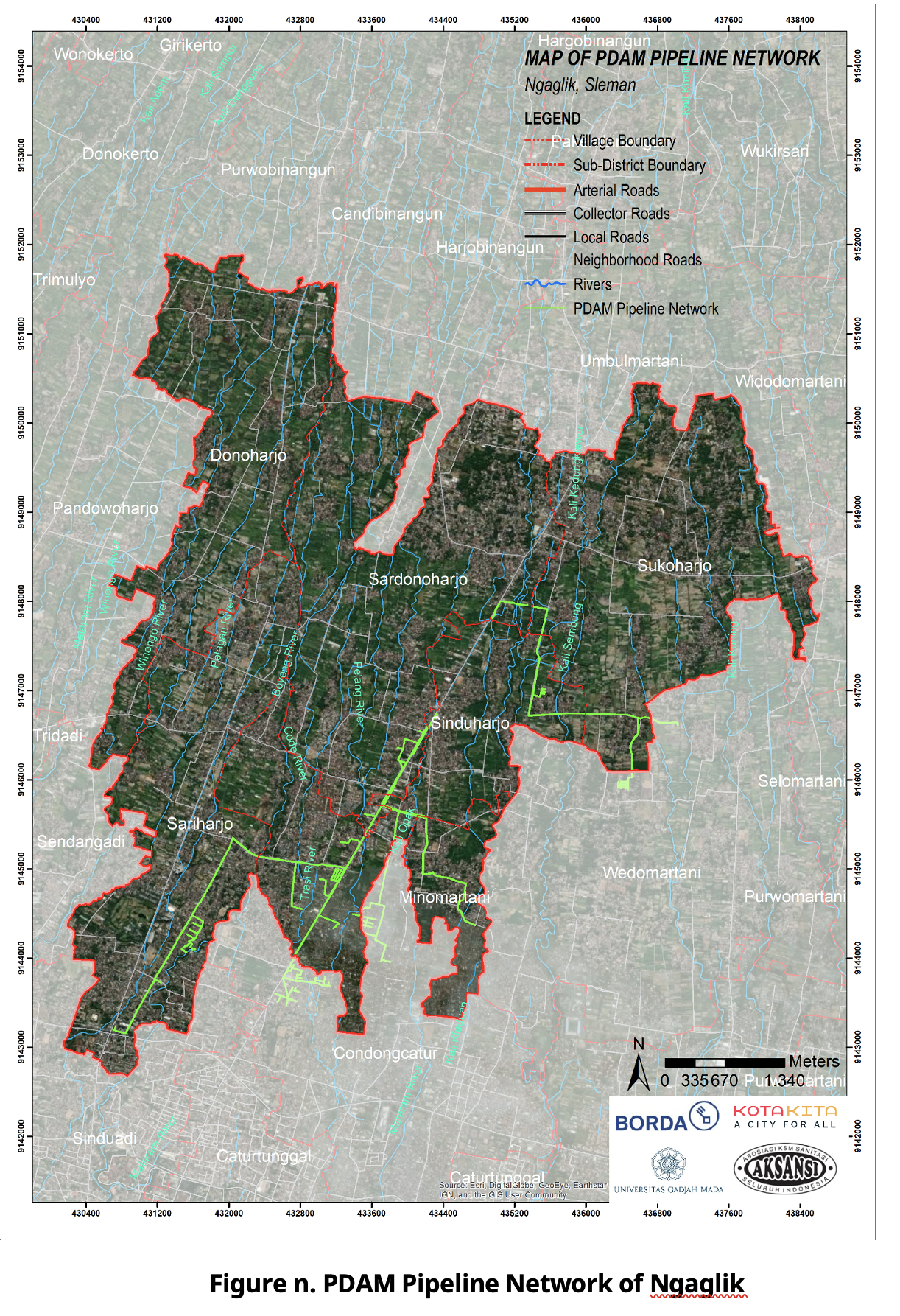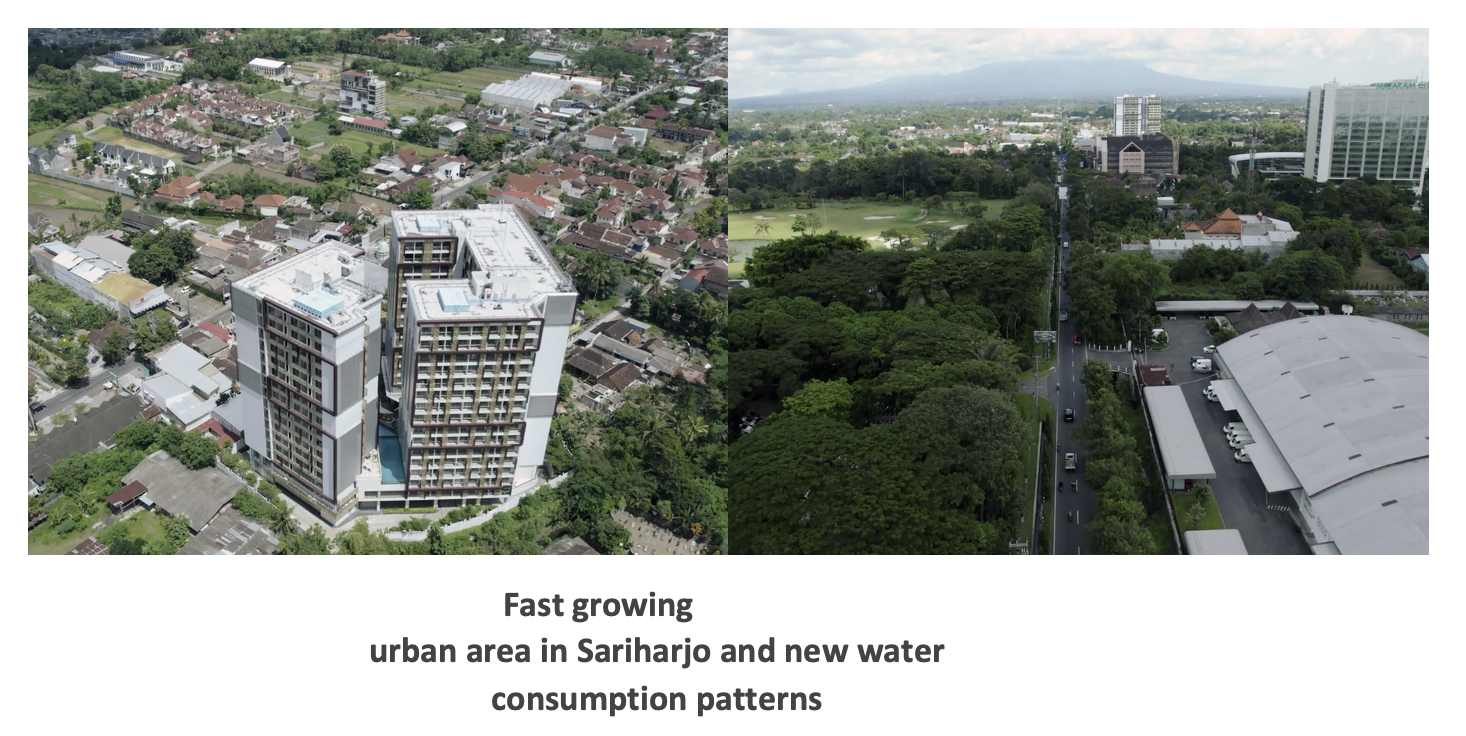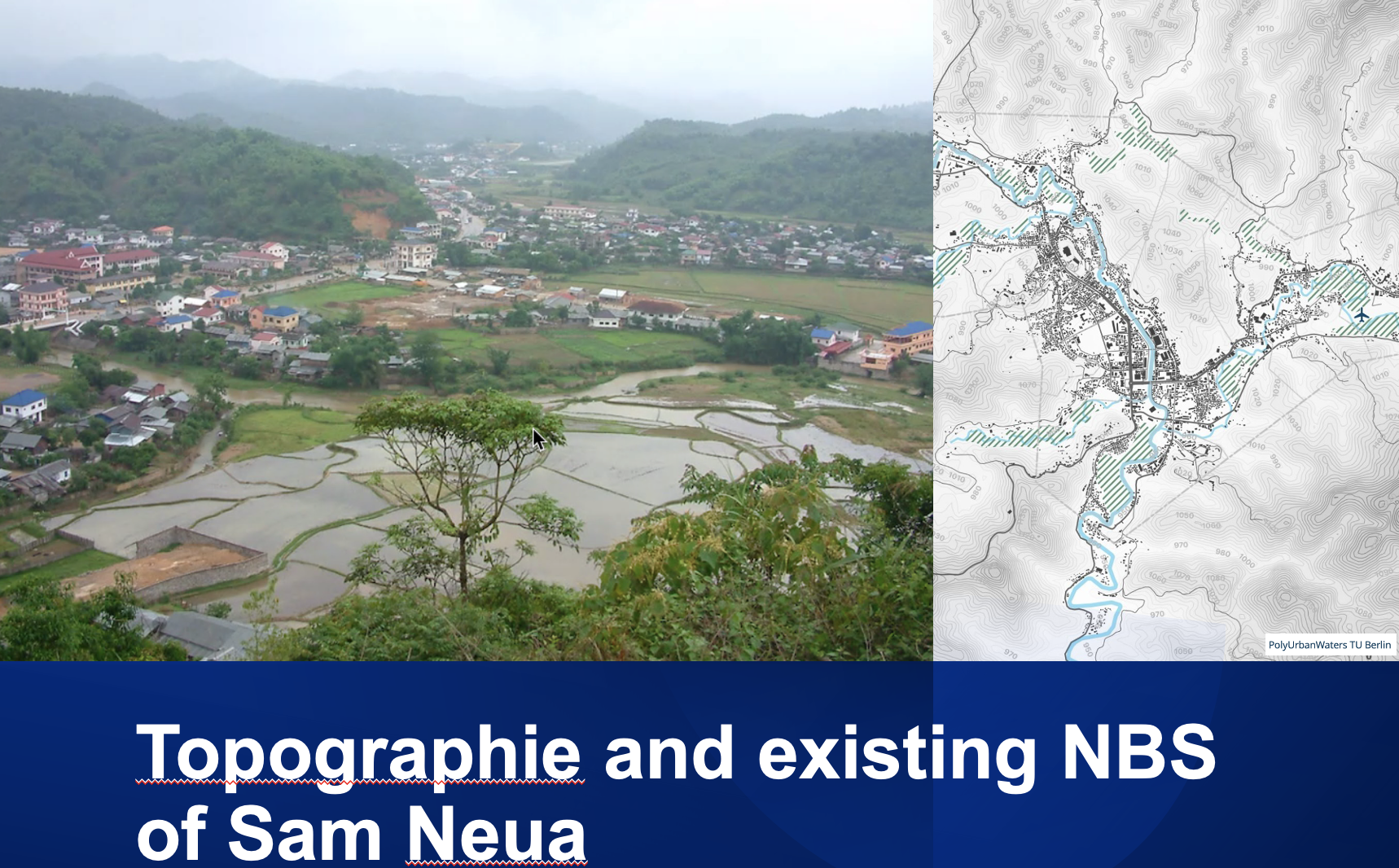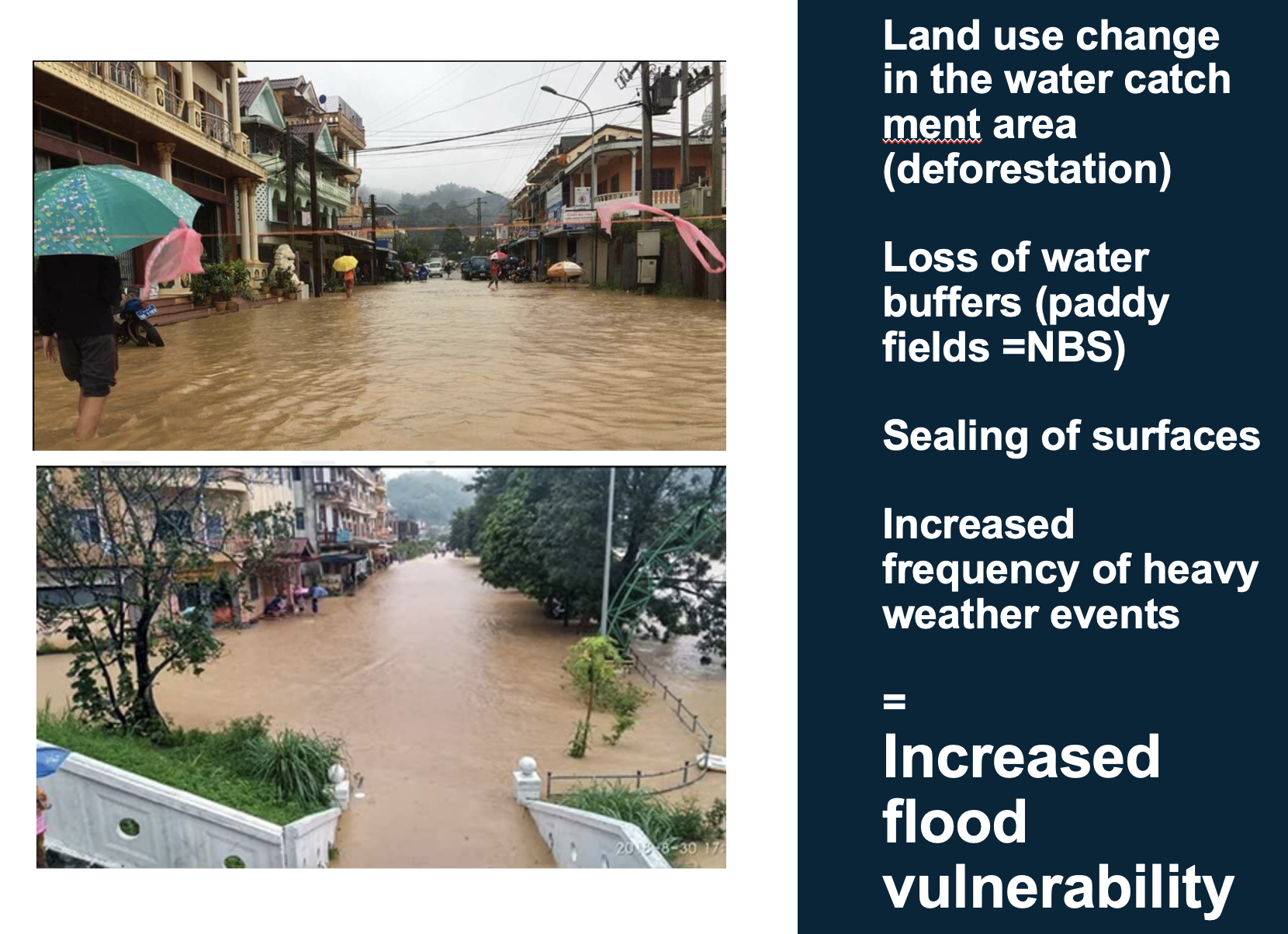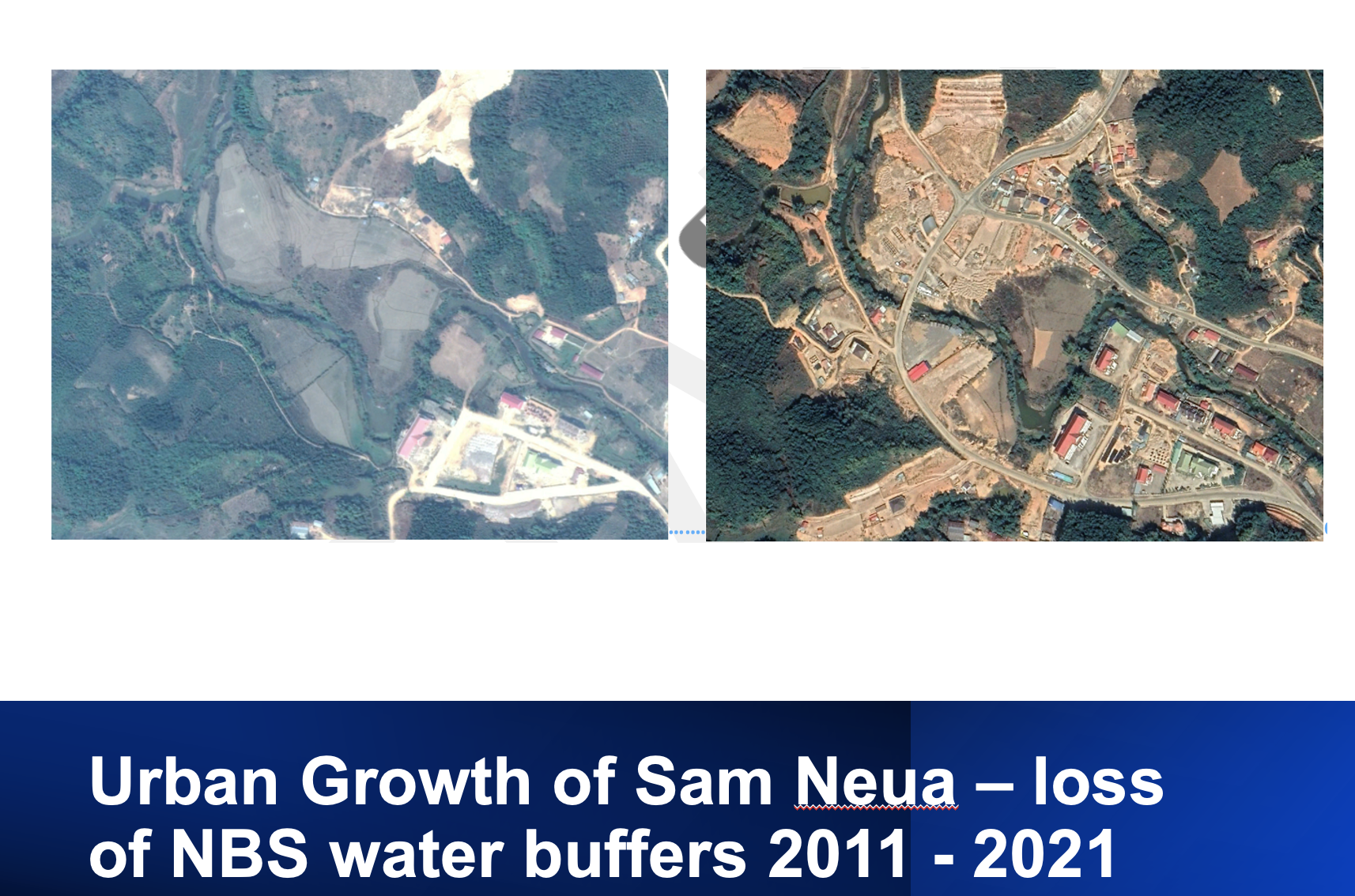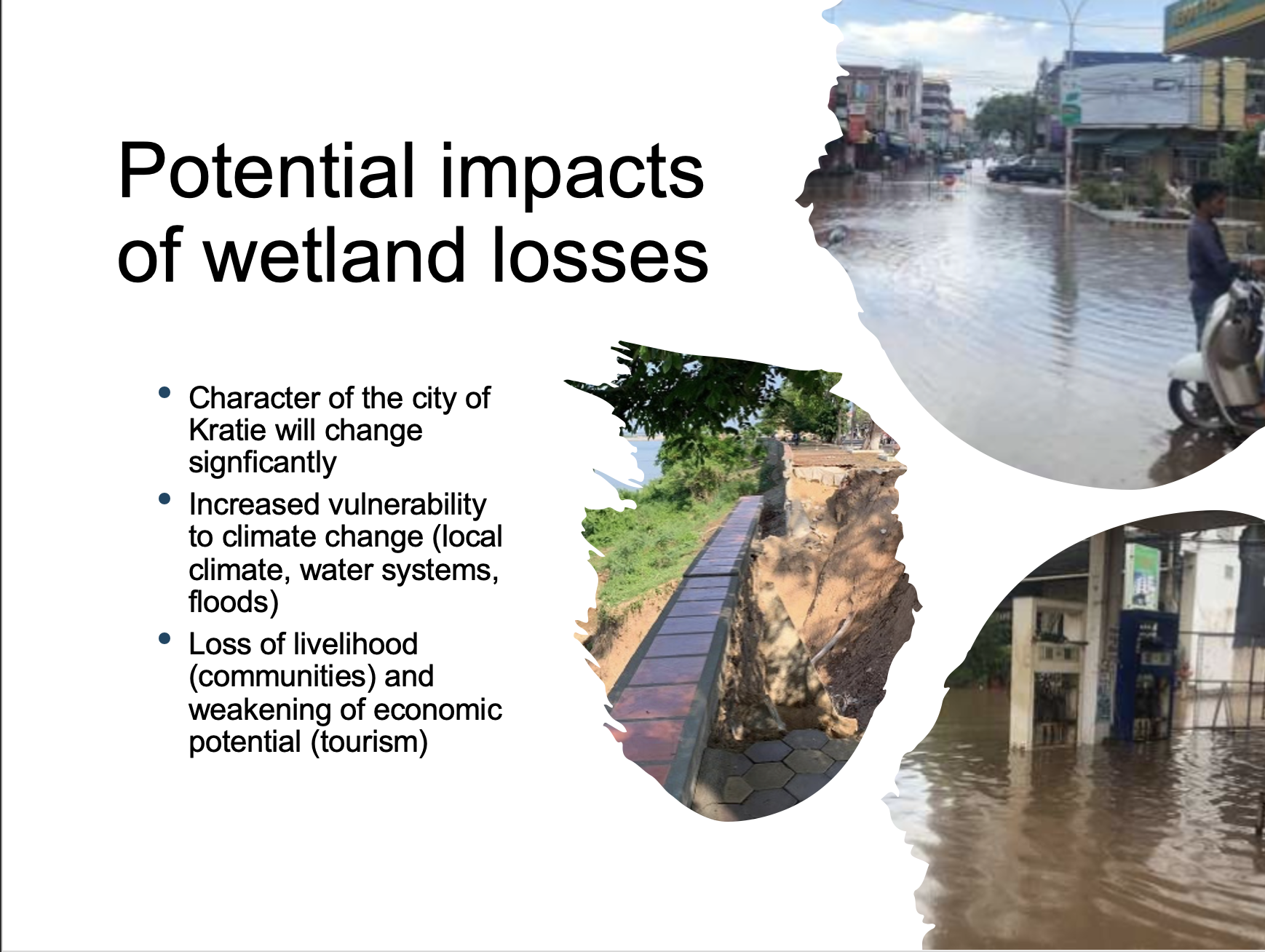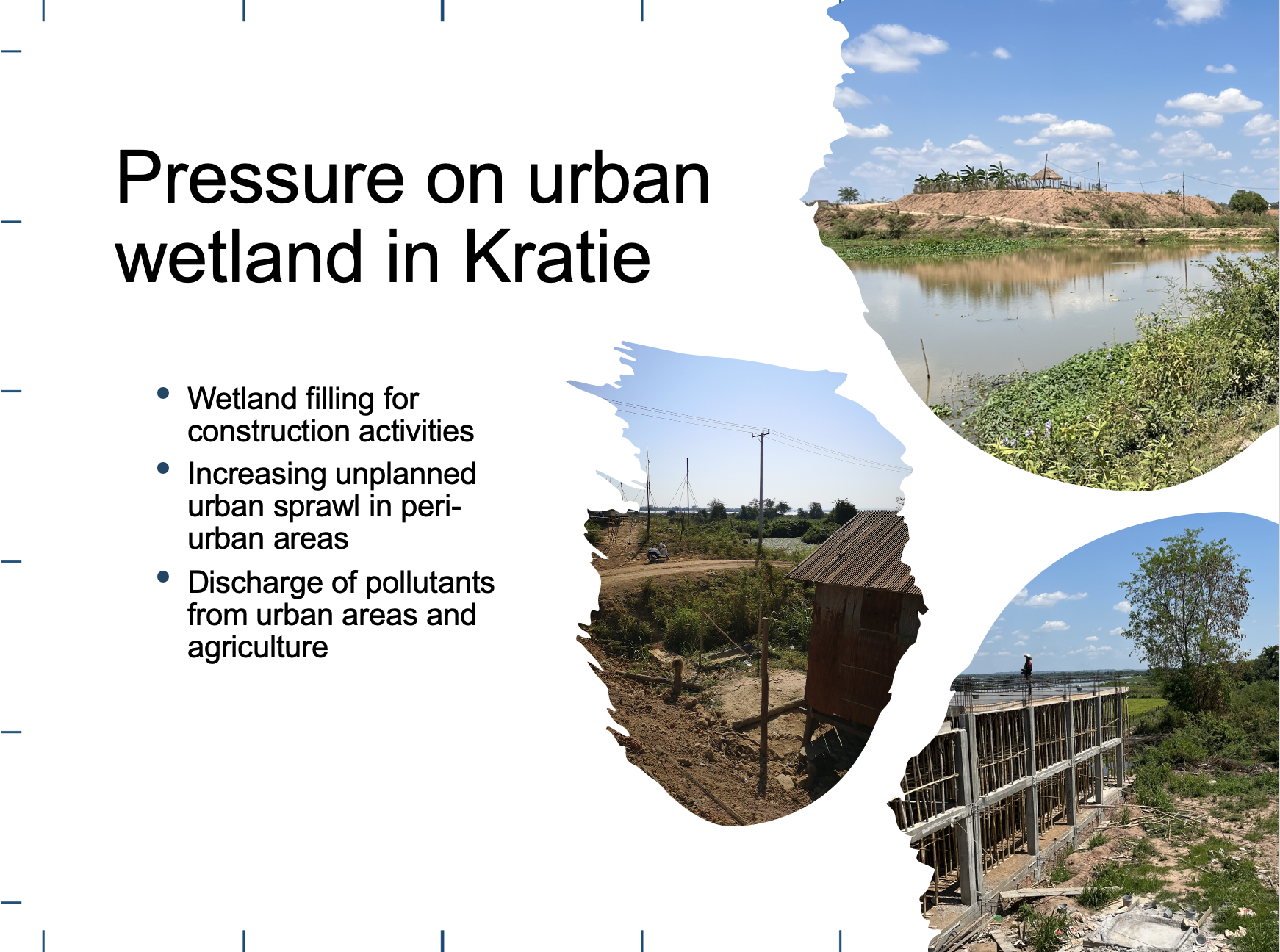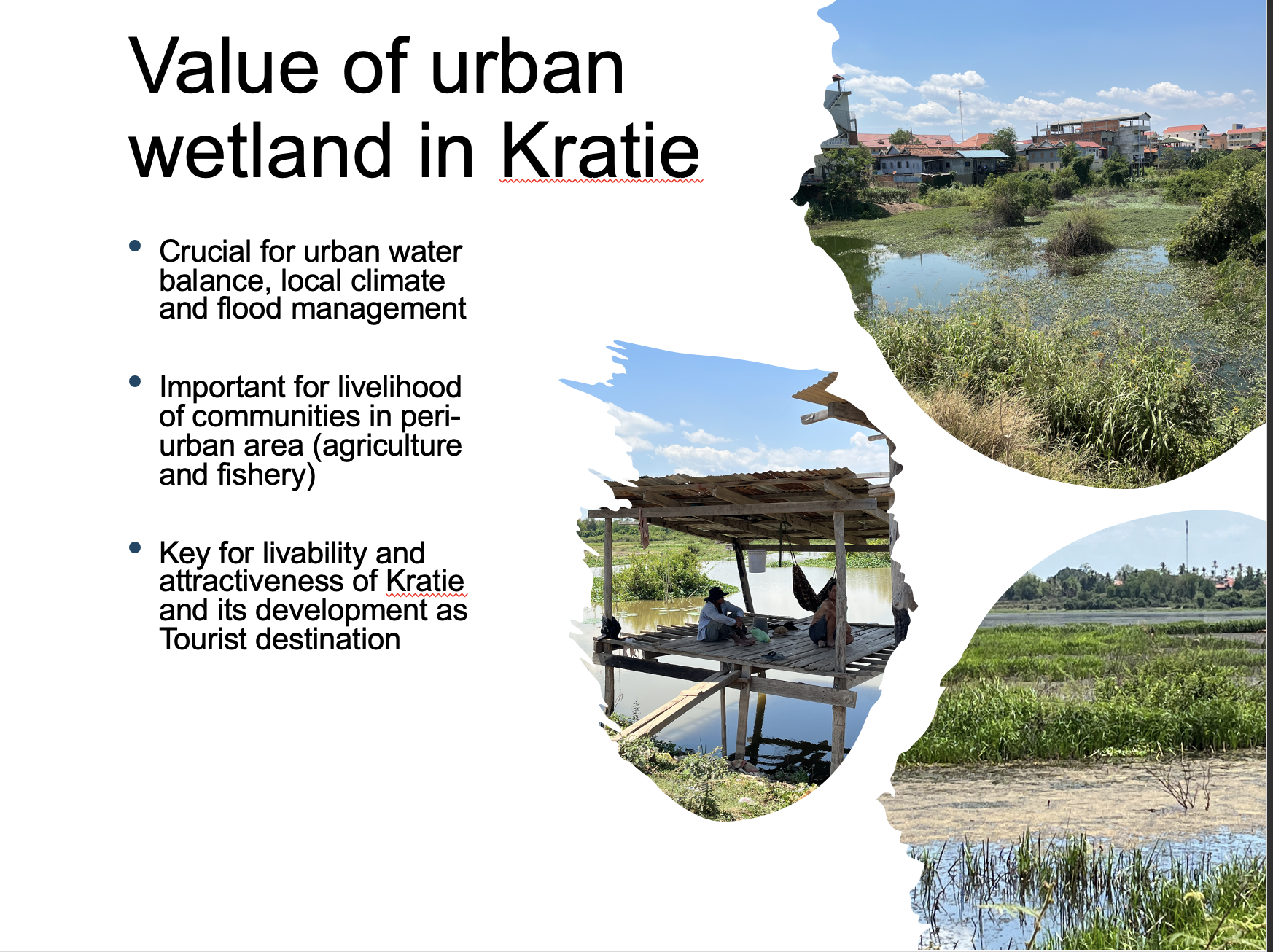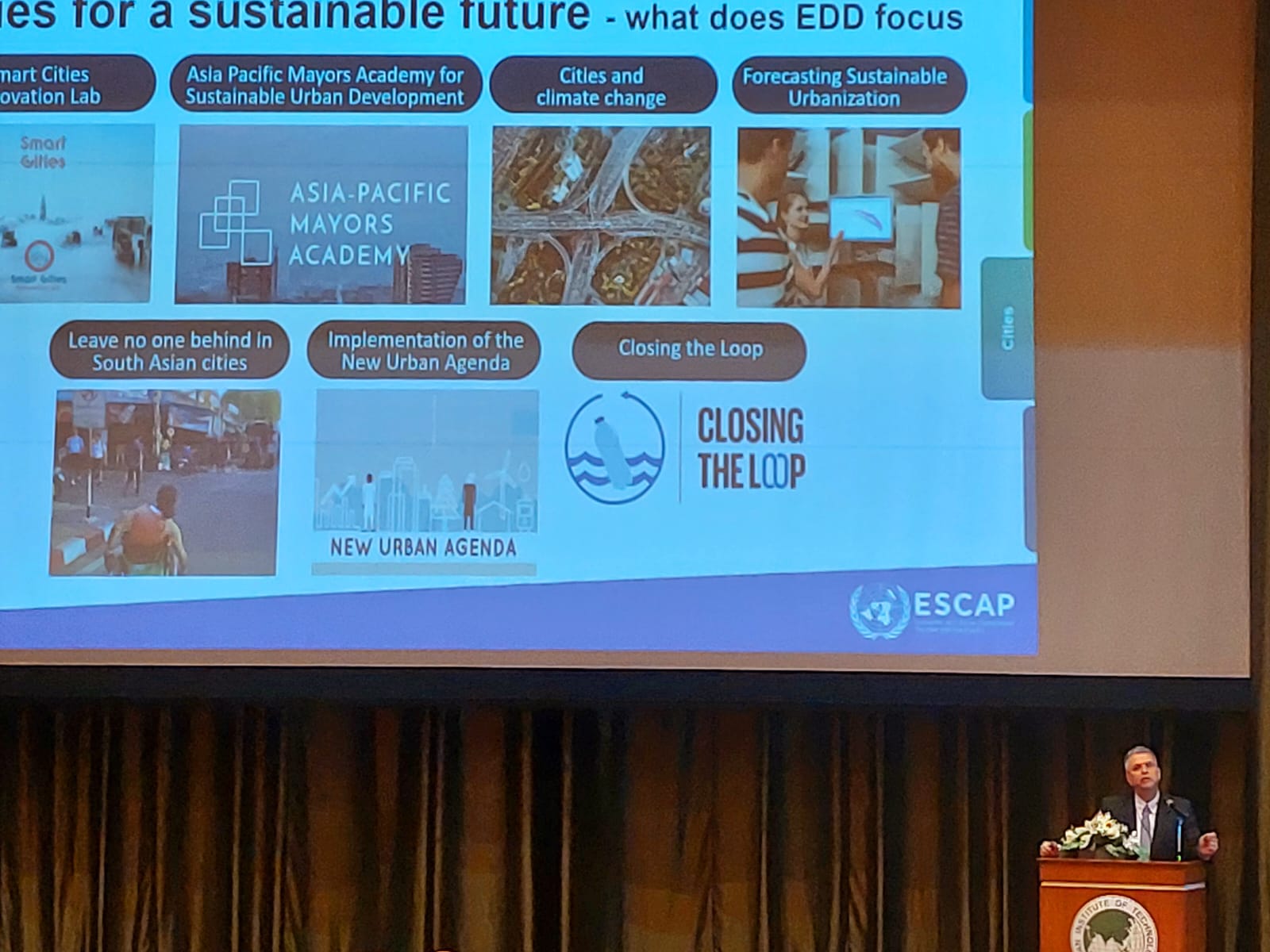
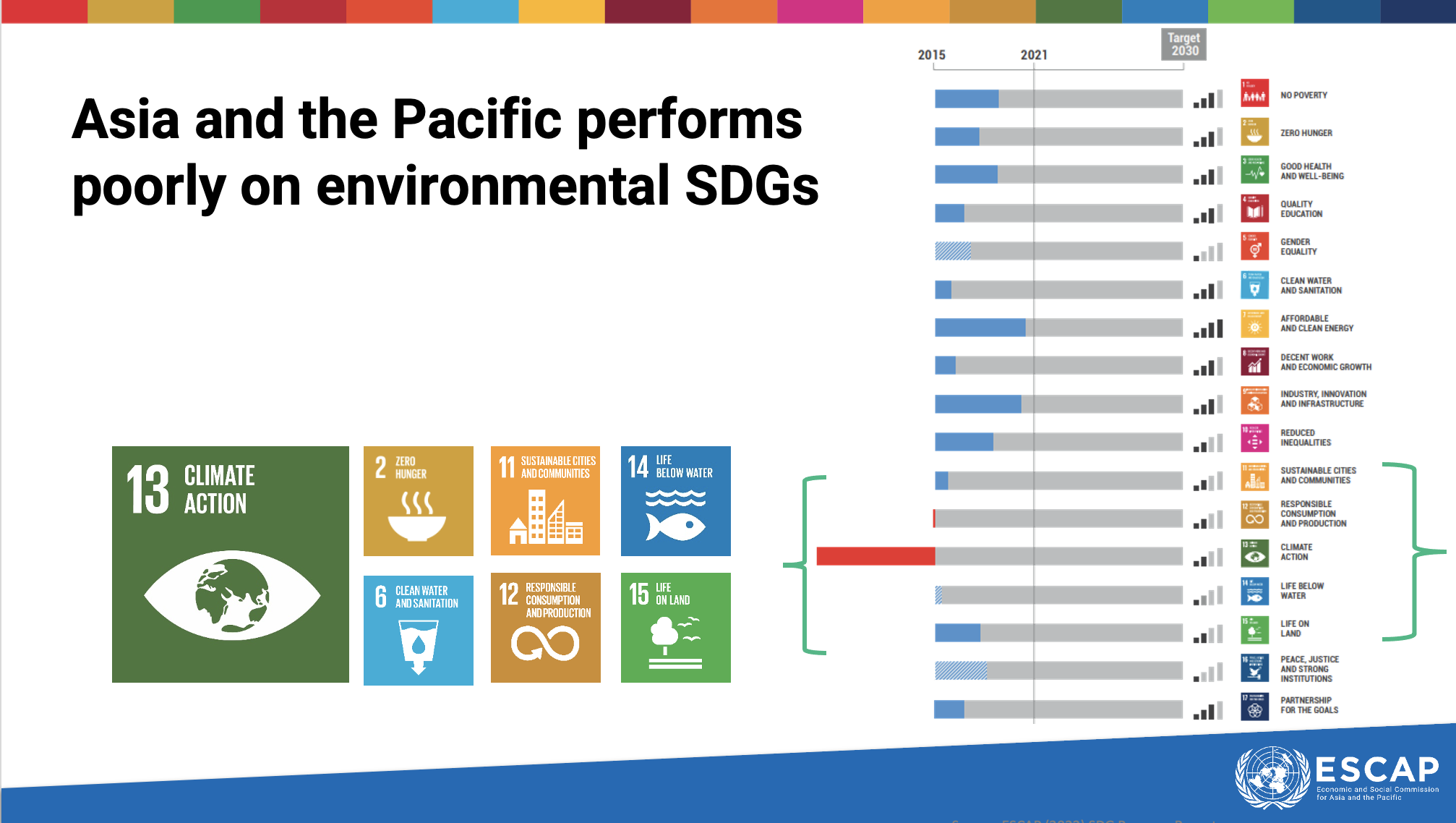
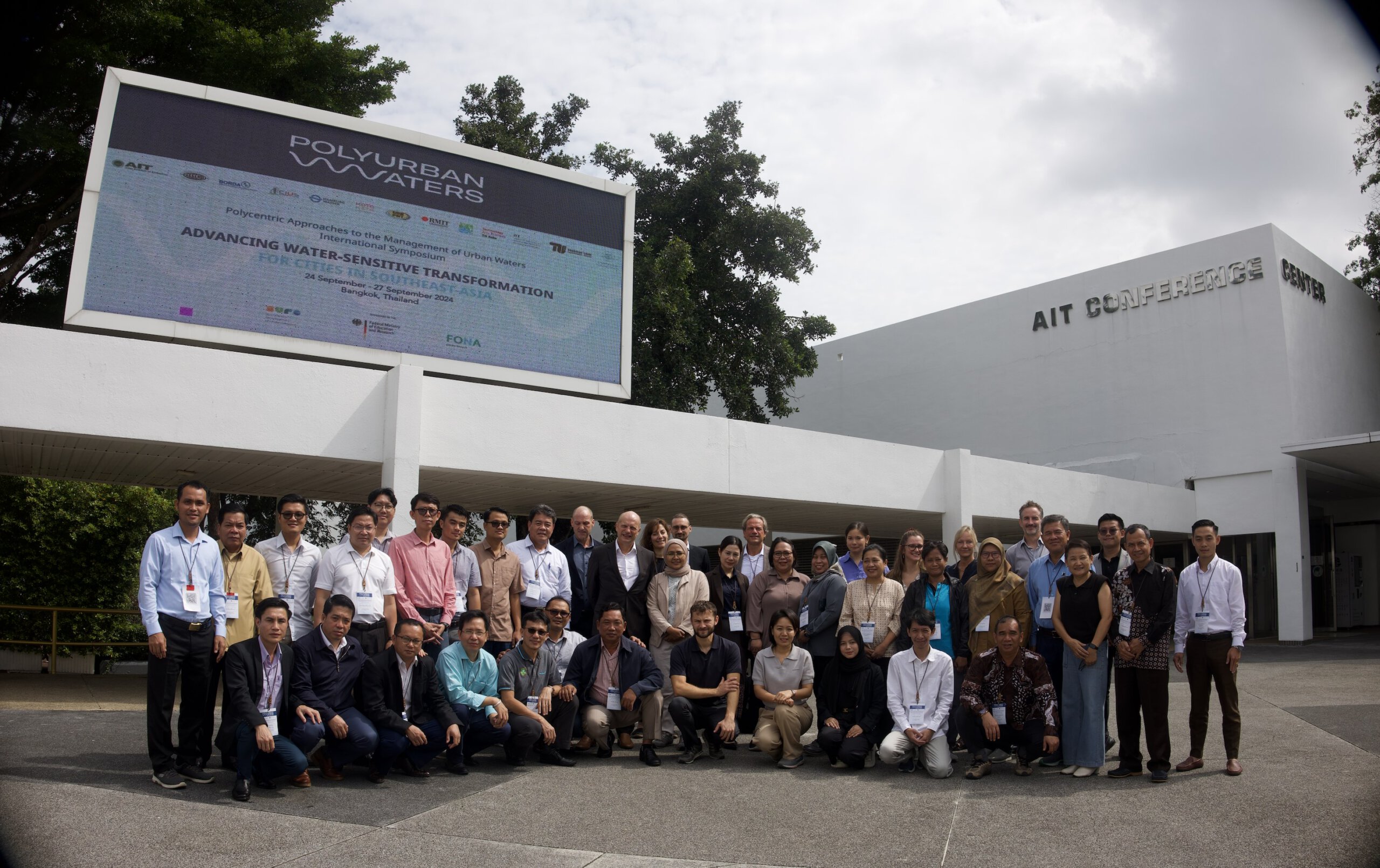
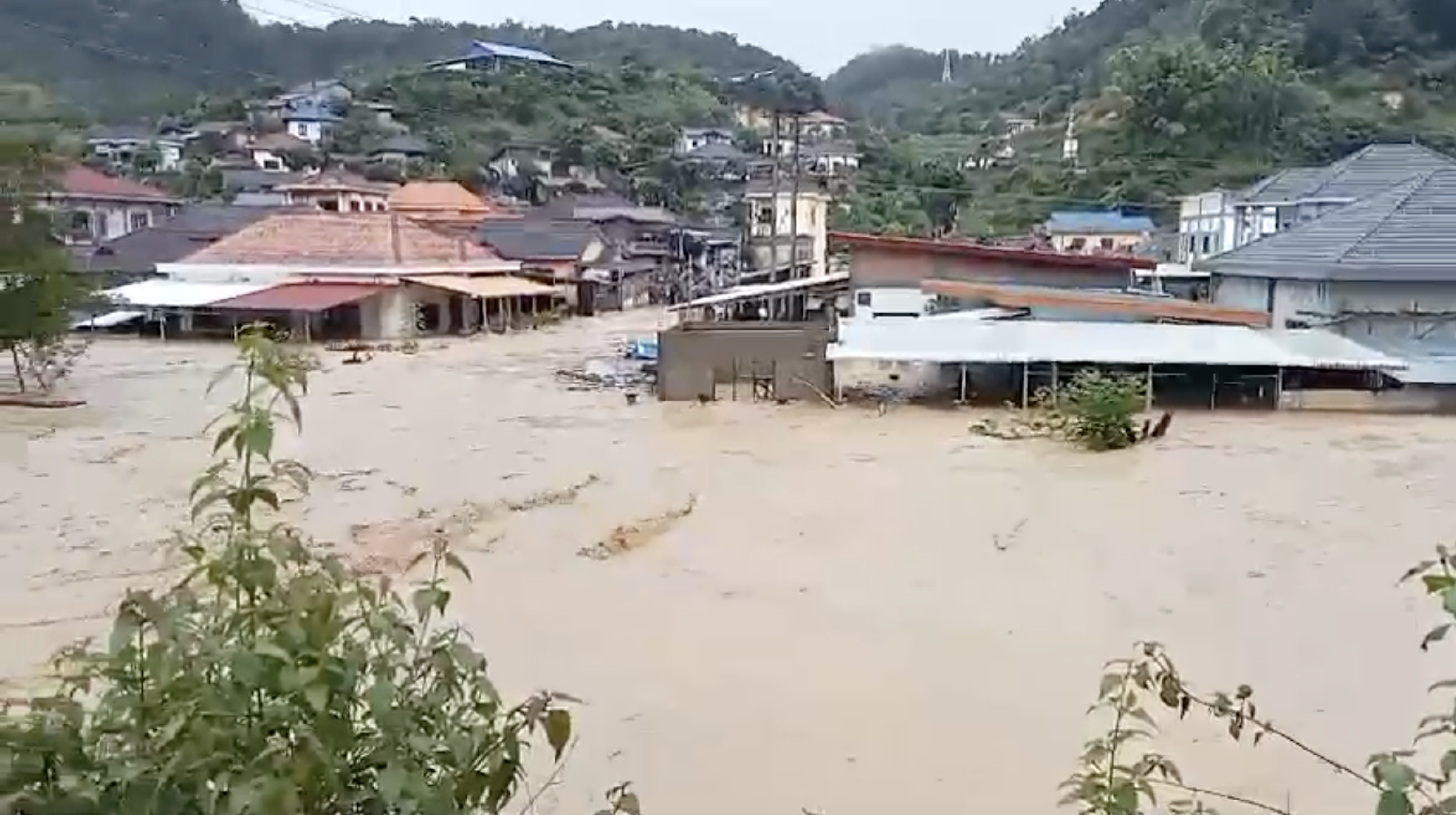
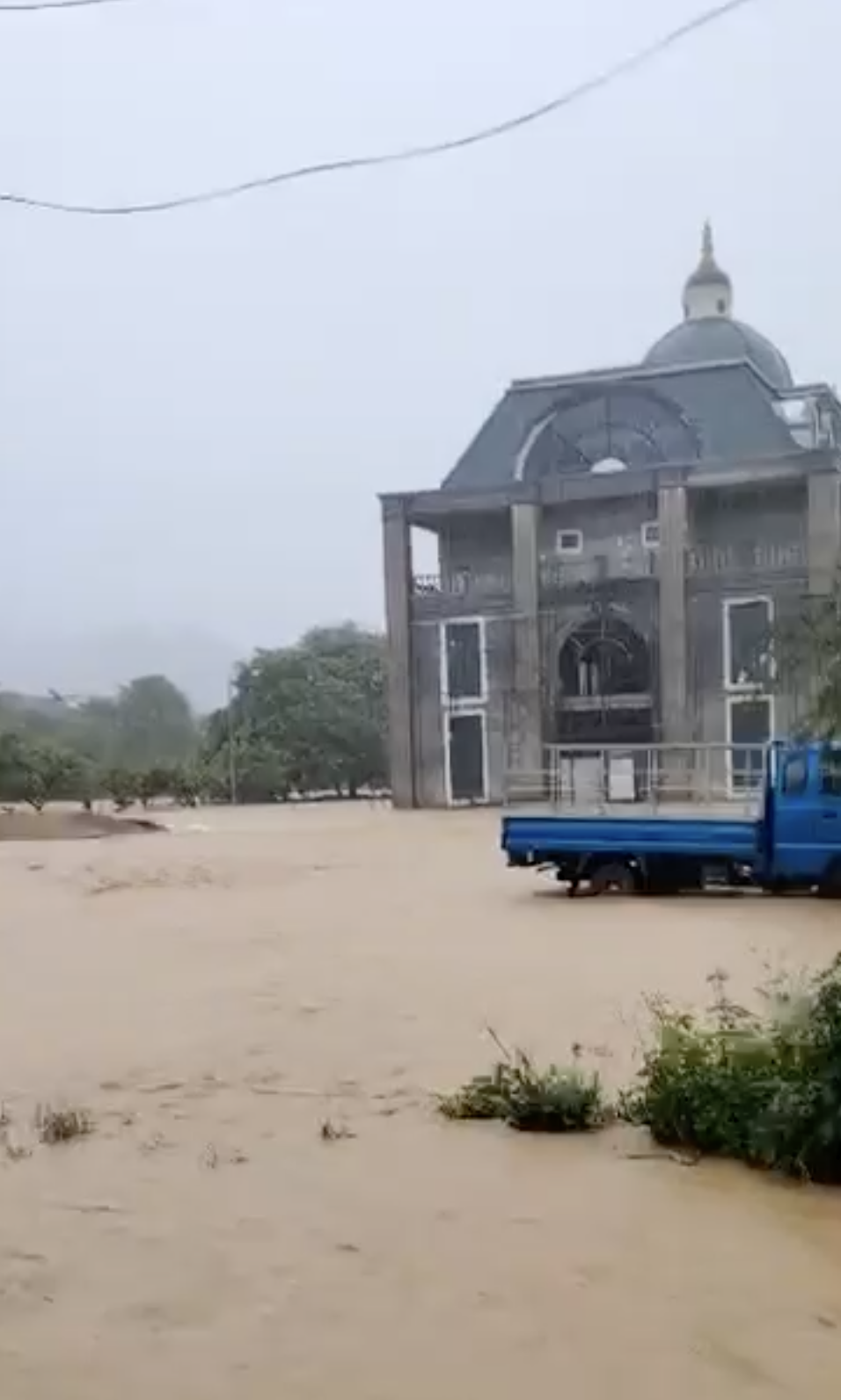
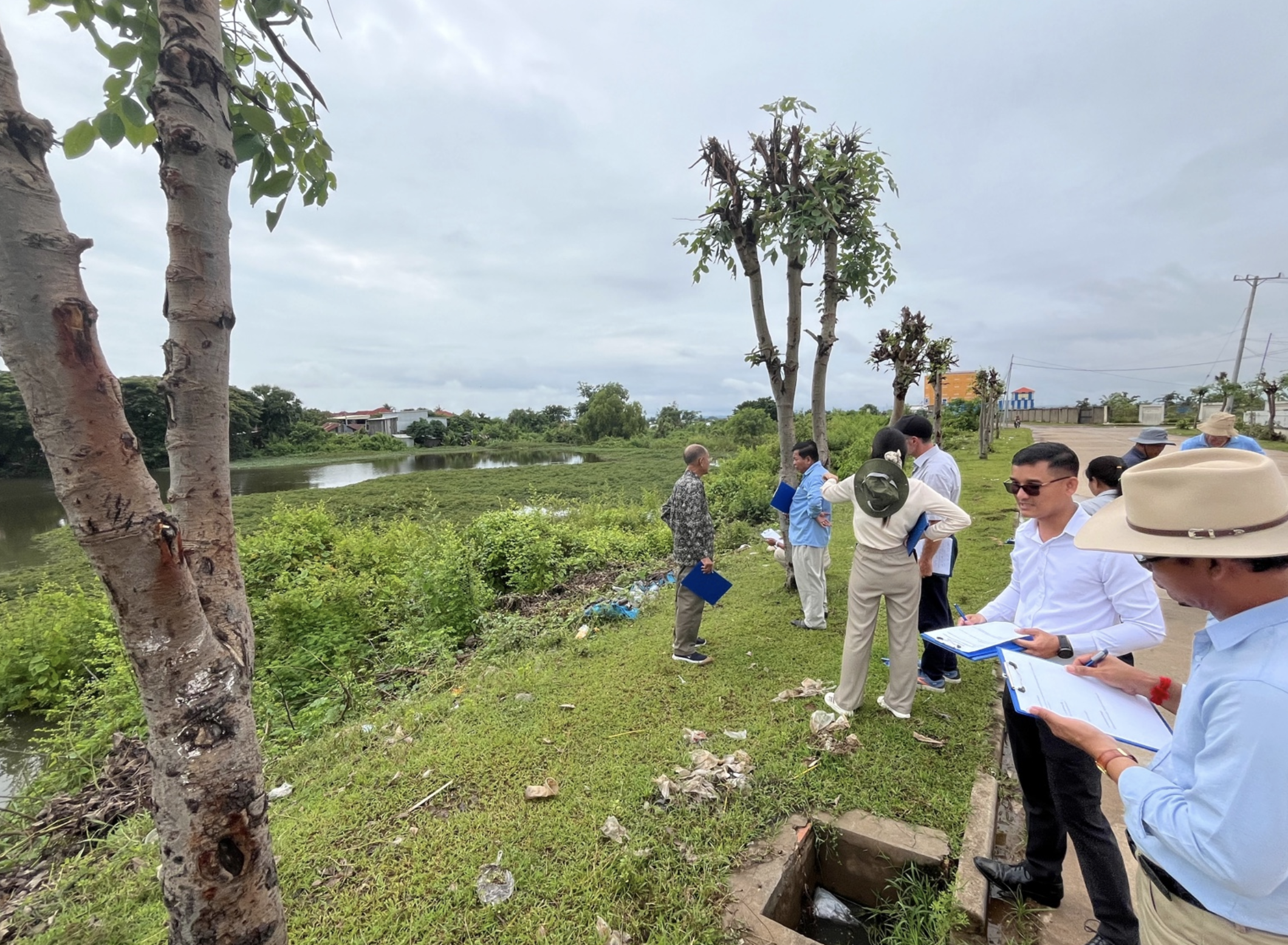
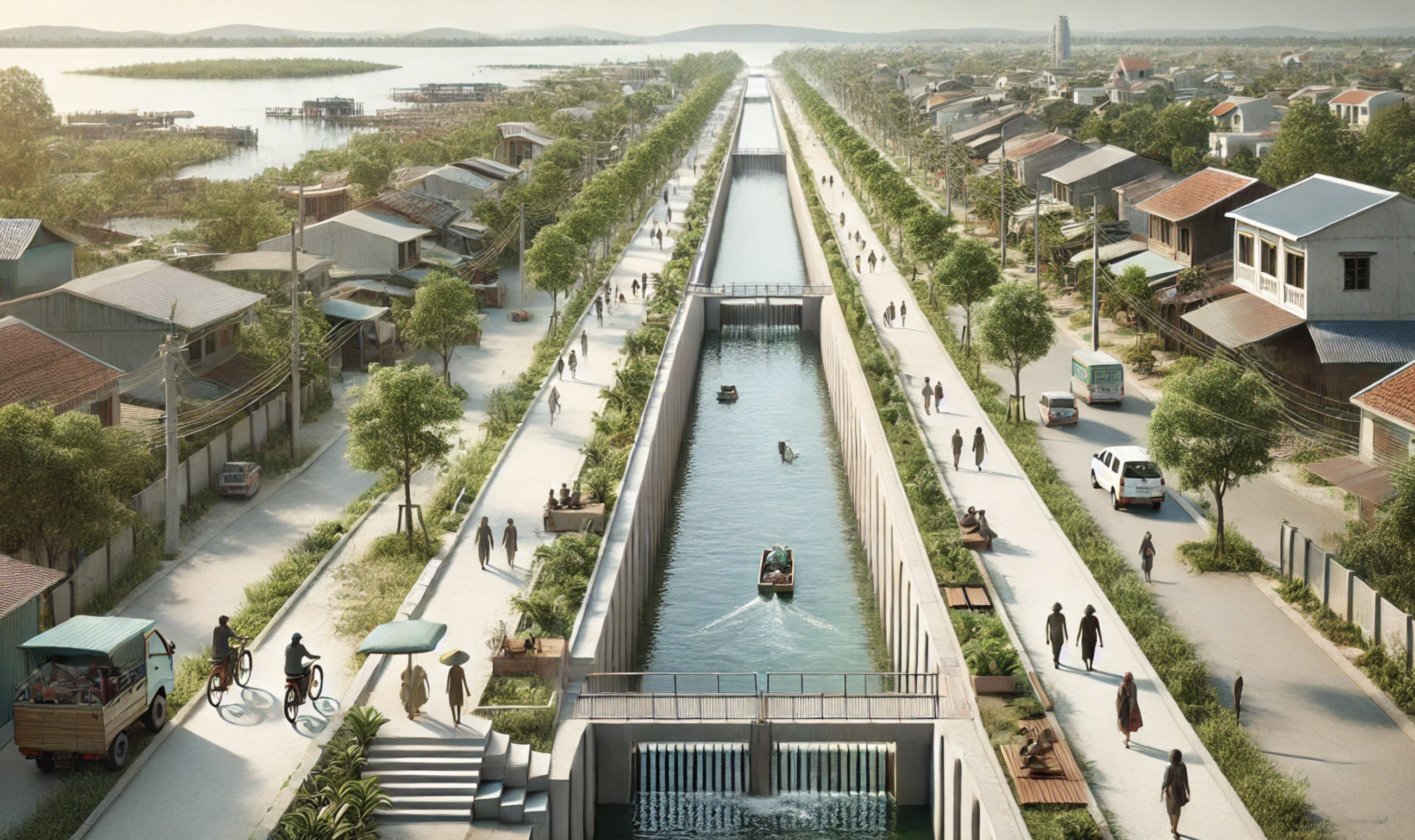

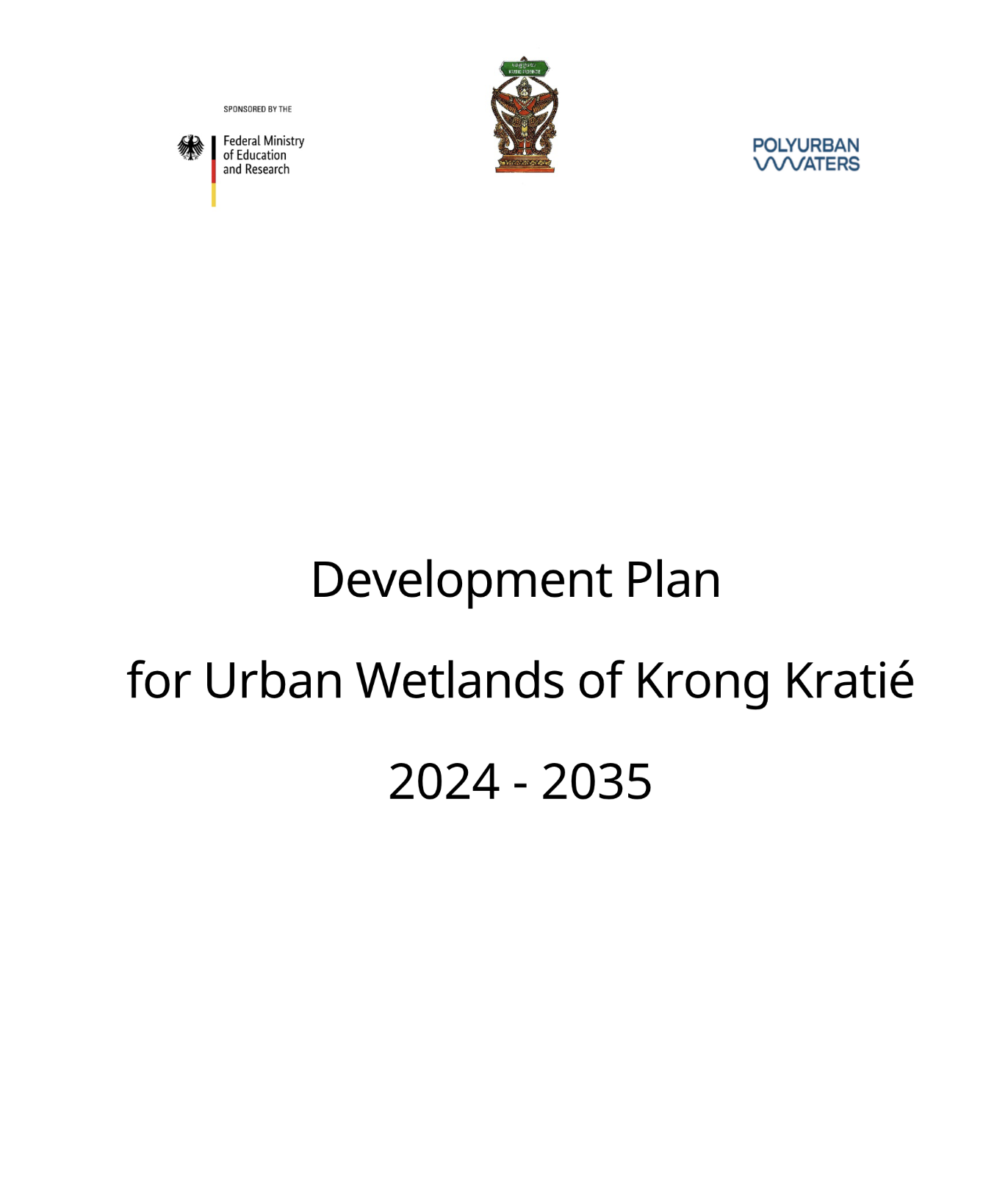

PolyUrbanWaters 2. Symposium at the Asian Institute of Technology, Bangkok, Thailand
Bangkok, 24 – 27 September 2024
The four-day PolyUrbanWaters Symposium brought together 32 representatives from partner cities and national governments, civil society and academia from Indonesia, Cambodia, Laos, Thailand and Vietnam. The aim of the symposium was to discuss the results of the project in detail during the research and development phase and to explore their relevance for implementation and scalability in Southeast Asia. The opening speech was given by Curt Carigan, United Nations Economic and Social Comission for the Asia and Pacific (UNESCAP).
In his speech, Curt Carigan pointed out that:
- Over the past 60 years, temperatures in Asia & Pacific have increased faster than the global mean.
- Extreme, unpredictable weather events and natural hazards have become more frequent and intense.
- The Asia and the Pacific performs poorly on the environment related Sustainable Development Goals especially in the field of Climate Action.
Among others, priority areas should be adressed such as
- Spatial Planning; Land use and zoning regulations; building regulations; protected areas
- Integrated water resource management: Controlled groundwater withdrawals; harvesting water and recharging aquifers; water treatment and recycling
- Infrastructure Investments- water facilities; water retention (sub-surface drainage; sponge city approaches); sea walls; deep wells)
PolyUrbanWaters Symposium 2024 AIT_Symposium Report_Published
2_AIT PolyUrbanWaters Seminar Sept2024 – UNESCAP 22 MB
PolyUrbanWaters Partner City Sam Neua/Laos severely affected by Flood Disaster
Sam Neua, 23 September 2024
In preparation for the upcoming PolyUrbanWaters Symposium, a delegation of government officials from Sam Neua, a partner city in Laos, along with representatives from the Ministry of Public Works and Transport of the Lao People’s Democratic Republic, gathered to discuss strategies addressing the city’s growing vulnerability to flood events. However, just a day prior, the city and its surrounding areas were struck by a severe flood disaster.
Days of heavy rainfall, caused by Typhoon Yagi, combined with the city’s mountainous terrain, ongoing deforestation in the catchment area, and inadequate infrastructure, led to a massive flood. The deluge inundated large parts of the suburbs and downtown areas.
PolyUrbanWaters’ vulnerability assessments and rainfall regime projections from recent years suggest that extreme flood events like this may become a new normal in the near future. The delegation emphasized the need for provincial and city-level governments to initiate a systematic approach to reduce flood vulnerability. This approach would include forest conservation efforts in the catchment area, the construction of water retention infrastructure, and the protection of riverbank vegetation zones that can aid in water infiltration and slow down flood surges.
Infrastructure Development for strengthening flood resilience of Kratié
20 September 2024
The water level of the Mekong in Kratie is currently approaching flood level again. Members of PolyUrbanWaters discussed priority flood protection measures during a workshop aimed at specifying the Area Plan for Urban Wetlands in Kratie. In this context, provincial and municipal authorities addressed the rehabilitation of the so-called “White Bridge Channel,” located in a new development area. Design options for the channel were discussed as part of green urban development.
Through the facilitation of PolyUrbanWaters, this measure was prioritized by government authorities. The channel is to be thoroughly cleaned, enclosed with flood walls, and flood gates installed. At the same time, the edges of the canal are to be developed into a recreational area for the city’s residents, meeting the popular demand to create pleasant and safe spaces for sports activities and relaxation. During the workshop, participatory surveys were conducted with citizens and city representatives, and initial design drafts were developed.
Province of Kratié seeks support from PolyUrban Waters for the implementation of Development Plan for Urban Wetlands Area
July 16, 2024
During R&D Phase an Development Plan for Urban Wetlands Area (DPUAW) was developed in co-production with the Provincial government and the government of Krong Kratie. In 21 July 2024, the Governor of Province of Kratié officially aknowledged the DPUAW the strategic value of the urban wetlands for the sustainable development of the city, its adaptation capacity to climate change and the cities overall water security.
The DPUAW addresses three strategic fields of action:
- Flood Management,
- Green Space and Recreational Area Development, and
- Wastewater Management.
The Provincial Governor, and the Deputy Mayor of Kratié City convened at the Kratié Provincial Office to deliberate on the preparations for the Project Implementation Phase (2025-2027) of the PolyUrbanWaters Project.
The plan will serve as the foundation for the Implementation Phase of the PolyUrbanWaters project, with the scientific team and local stakeholders working closely to implement its elements inncollaboration with international funding streams from international donors such as BMZ and ADB. The government of Kratié Province will disseminate the DPUAW and experiences made during implementation phase through national level working groups and the planned National Committee on the Management of Urban Wetlands.
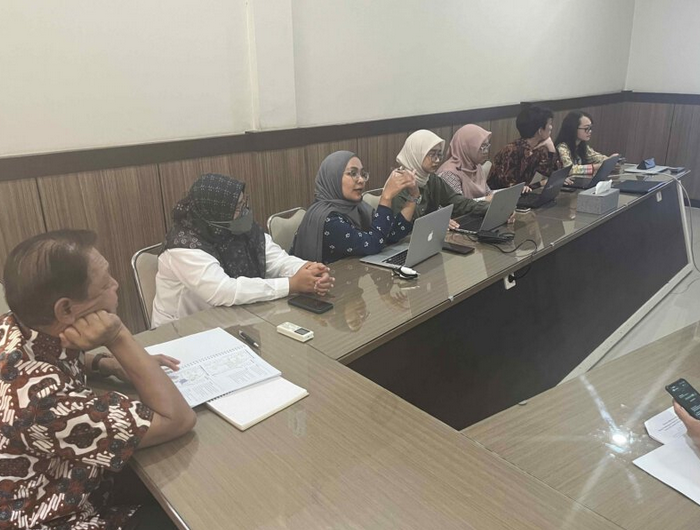
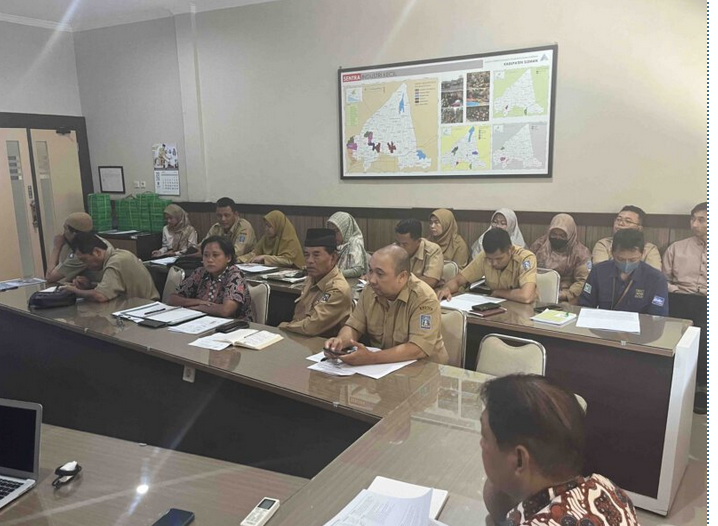
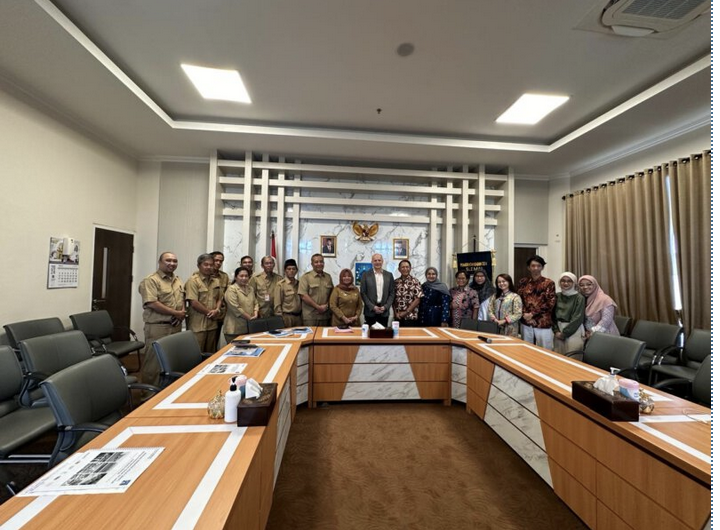
PolyUrbanWaters Indonesia Team hands over Policy Brief to the Regent of Sleman Regency and the National Planning Agency BAPPEDA
15 March 2024
The PolyUrbanWaters team has summarised the findings, learnings and recommendations from the process “Towards a water sensitive Sariharjo/Sleman” in a policy brief, which should be relevant not only for Sleman but also for other regions in Indonesia.
The key points are
1) Rapid urban transformation is comprehensively changing the social structures of peri-urban areas. The former self-governance structures, especially those of the communities, are under considerable pressure. New participatory procedures for citizen/community involvement should be included, especially with regard to more water-sensitive residential areas and in official procedures for municipal and infrastructure development.
2) There is great awareness among relevant stakeholders at government level and communities that the development of water-related infrastructure and management systems is severely inadequate to meet the challenges of urban transformation and the consequences of climate change. In order to prevent social segregation between new development areas and “traditional settlement areas”, e.g. in terms of water supply, public services such as those provided by the water operator PDAM should be rapidly expanded. Community-based service provision can at most fulfil a “bridging function” in individual cases.
3) A technically effective configuration between grey infrastructure development and the use of nature-based solutions is required to ensure the water security and livability of settlement structures. This is particularly evident in stormwater management. Among other things, village treasury lands, i.e. community-owned land, which is also coming under increasing pressure from settlements, should be strategically utilised for this purpose.
The Regent of Sleman Regency expressly welcomed these recommendations, suggested concrete detailed planning in the respective districts or “villages” supported by the project and held out the prospect of funding for prioritised individual measures.

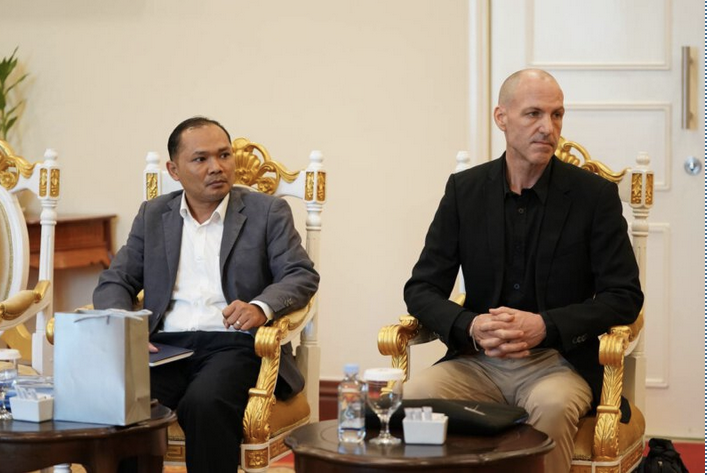
13 March 2024
Deputy Prime Minister of Cambodia invites PolyUrbanWaters to contribute to improved management of urban wetlands
PolyUrbanWaters representatives were received by His Excellency Mr Say Sam Al, Deputy Prime Minister and Minister of Land Management and Urban Development of the Kingdom of Cambodia.
The Royal Government of Cambodia (RGC) has adopted the Pentagon Strategy, Phase 1. This strategy is aimed at laying out Cambodia’s pathway to becoming an upper-middle-income economy by 2030 and a high-income economy by 2050 through the modernisation of the government and stimulating future economic growth. It outlines five key objectives: build human capital; diversify the economy and enhance competitiveness; develop the private sector and employment opportunities; promote resilience, sustainability, and inclusive development; and strengthen the digital economy and society.
In this context, the sustainable management of cities will also be given a new focus. In view of the increasing flooding events in cities and the loss of biodiversity, there are initial considerations as to how urban wetlands with their diverse ecosystem functions can be better protected.
PolyUrbanWaters was invited by the Deputy Prime Minister to become a member of a “National Committee for the Sustainable Management of Urban Wetlands”, which is currently being established, and to contribute the results of previous and future work.
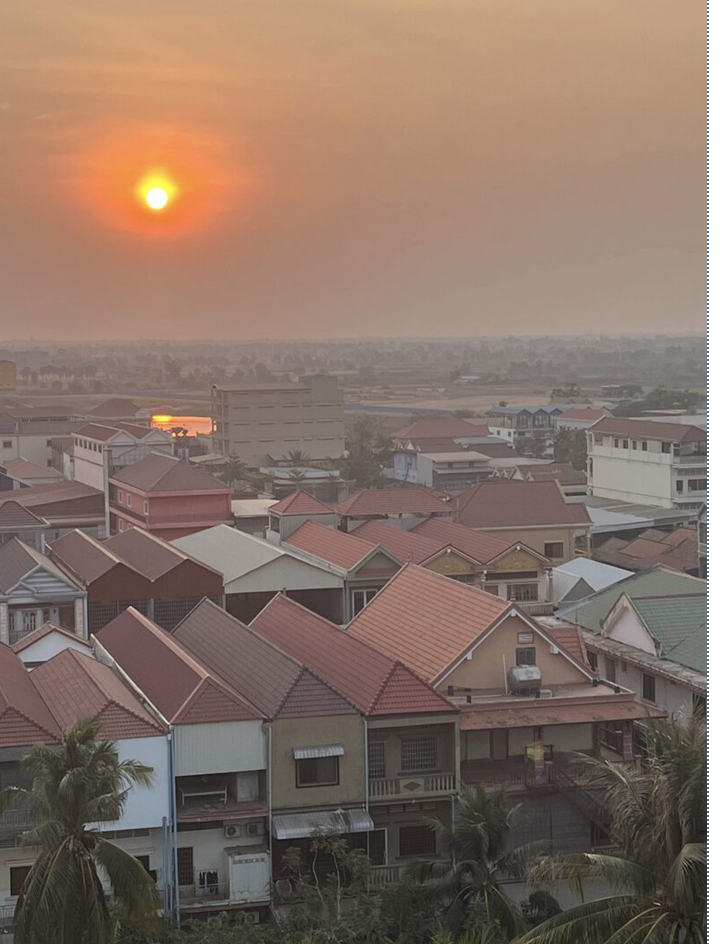
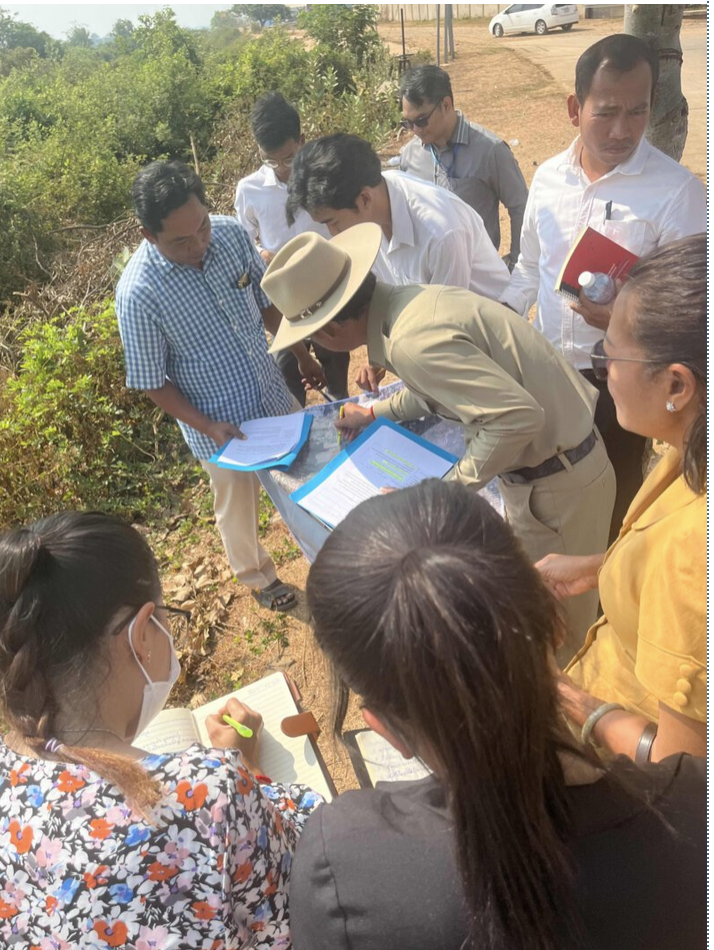
11 – 12 March 2024
Local government and communities of Kratié start to elaborate strategy on climate change adaptation
As the Base-Line Study towards a Sustainable and Water-Sensitive Krong Kratié has shown, average temperatures in the city have risen due to the impact of climate change, and scenarios indicate they will likely continue to rise.
In developing a climate change adaptation strategy, city administration members and communities have identified strategic measures during a workshop and insect walks through the city. These measures focus particularly on urban wetlands (lake areas) as part of the urban expansion process to mitigate the urban heat island effect during the dry period and reduce vulnerability to floods during the rainy season.
The following strategic measures were identified:
1) expansion and safeguarding of the green infrastructure within the so-called Lake Area for recreational activities and the expansion of green spaces;
2) securing the flow regime of floodwater in the Lake Area by improving the drainage and dam infrastructure; and
3) decentralized approaches to wastewater treatment.
These measures are to be progressively incorporated into a Lake Area Plan 2024-2035 by the end of 2024, which will support the water-sensitive transformation of Kratié.”
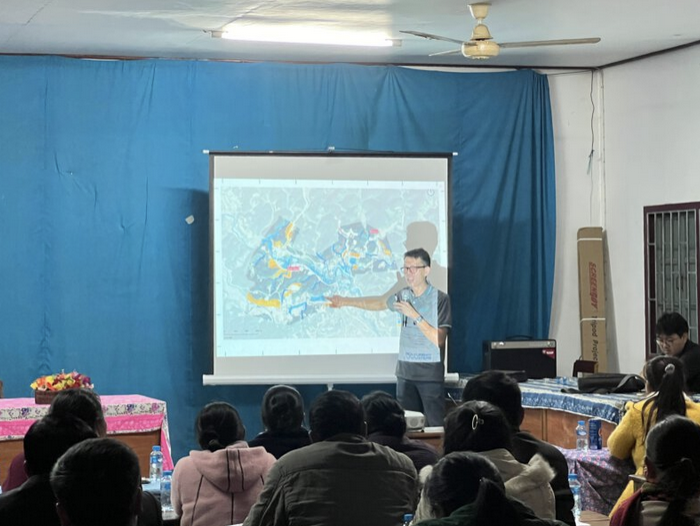
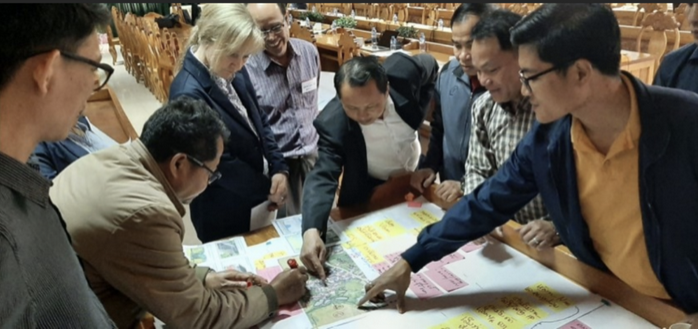

2 February – 15 March 2024
The town of Sam Neua identifies strategic projects to initiate water sensitive transformation in its extension areas
With support of the PolyUrbanWaters (PUW) project and the German water operator Hamburg Wasser, government agencies and communities have identified projects for water sensitive transformation. The projects are strategic because they address crucial challenges for the management of urban waters. Visible and relevant pilot projects will be designed to initiate a cross-sectorial learning and capacity building process at the interface or local governments and communities that not only will contribute to solve specific water challenges but strenghten the governance structures as well.
- Stormwater and drainage planning – Standard Operational Procedures and regulations in urban extension area for households, private plots and public settlement area and their integration.
This initiative addresses the current absence of standard procedures or building regulations to effectively guide planning and control construction of new households and public spaces in terms of stormwater runoff. To effectively manage the increased stormwater runoff resulting from urban expansion (new households and settlement area), the initiative develops strategies that focus on controlling stormwater at the household / plot level and the integration with stormwater system of the broader surrounding public settlement area.
- Updating of Urban Planning (Landuse Zoning Plan – incorporating WSUD principles and prohibited construction areas).
This initiative is aimed to overcome the town lacks an official, up-to-date urban planning map to steer and regulate the planning of the urban extension area. It will revise the “Urban Planning” (Land Use Zone Plan), adhering to the official Lao Urban Planning process activity steps in the Urban Planning Manual by integrating water-sensitive development principles to direct and manage expansion in the urban extension area and the town, as well as prohibited/high control construction areas.
- Multi-functional Riverbend Green Space / Recreation Park in Sam Neua Village
This initiative aims to the develop a multi-functional flood retention/ recreation park along a large bend the Nam Sam River in Sam Neua Village, employing Water Sensitive Urban Design (WSUD) principles and Nature-based Solutions (NbS). The park will integrate flood management, recreational facilities, and environmental conservation.
- Wastewater Management – implementing DEWATS for selected priority sites
For the development of the urban extension area’s Wastewater Management System, it is intended to integrate DEWATS (Decentralised Wastewater Treatment Systems) and enhanced septic tanks as key infrastructure solutions. These will be implemented at selected priority sites, which include a range of new residential housing clusters, as well as in older established residential areas.
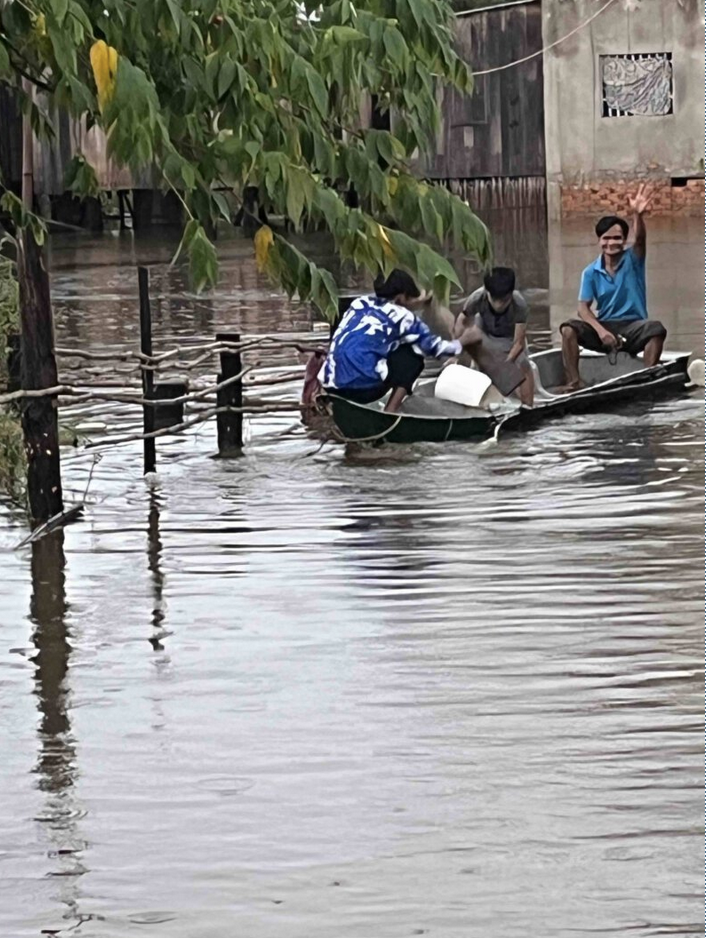
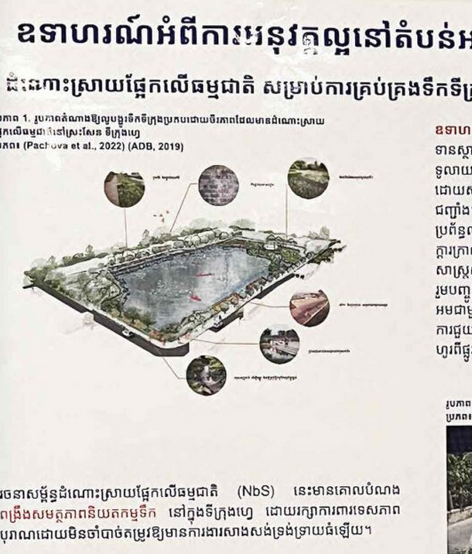

3 October 2023
Vision building process in Krong Kratié started
When the PolyUrbanWaters team arrived in Kratié, a massive storm front was building up, which eventually led to widespread flooding in the city. Accordingly, the city and Sangkat representatives were focused on addressing the need for effective flood protection.
During the vision-building workshop, examples from the region were used to discuss initial approaches on how the city’s wetlands and lake area in particular can be
systematically integrated into the development of green infrastructure.
In Cambodia, the discussion on how to address the increasing flood events is intensifying. In Kratie, too, a few projects have already been started to manage the
water flows through improved infrastructure, especially during the flooding season. For example, work is already underway on the so-called ‘White Bridge Channel’, which will enable an improved water flow to the lake area.
However, it became clear during the workshop that a coherent picture of the flooding situation and its relevant influencing factors is still missing among local stakeholders and local authorities. The base-line study has raised awareness of the importance of wetlands for the flooding regime. Nevertheless, a more detailed understanding is now needed to identify and implement appropriate measures.
The workshop also showed that the question of what sustainable wastewater management can look like is still open. Plans for a central wastewater plant with a
lagoon system still require technical specifications. The question of long-term management and financial viability are also still unresolved.
The relevance of decentralised wastewater management is obvious, especially in the outer areas of the sangkats. Here, targeted technical measures for the treatment of wastewater in hotspots, such as the slaughterhouse and the establishment of an
efficient sludge management system, are identified as priority tasks.
All in all, it became clear during the workshop that a comprehensive approach to water management challenges, such as the approach taken by PolyUrbanWaters, is new to the local stakeholders. It is also new that both the analysis and the identification of solutions are found in participatory processes.
It is obvious that the vision building workshop that has now taken place should be a kick-off to a longer capacity building process.
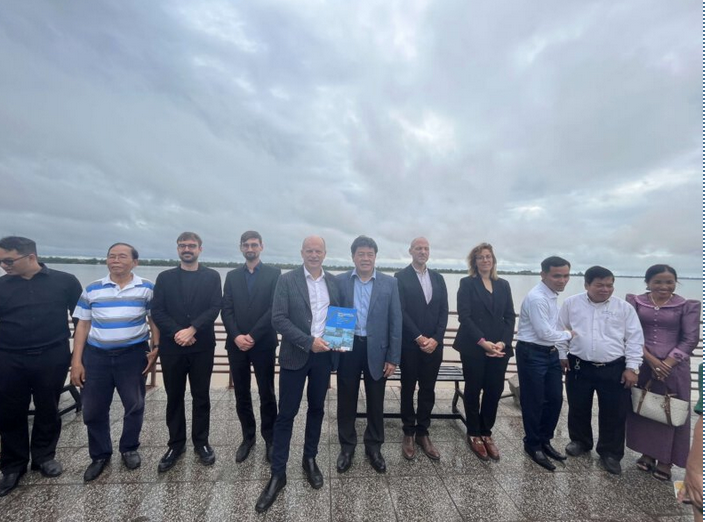

2 October 2023
“Baseline Study Kratié” officially handed over to Vice-Governor of Kratié-Province and officials of Krong Kratié
As part of a workshop to verify the results of the “Baseline Assessment Kratié” and in preparation for the vision-building workshop for a water-sensitive Kratié, the study, which was developed over two years, was handed over to the provincial and municipal governments.
In the presence of the Sangkat chiefs, the main findings were again discussed in depth and the basis for strategic development and vision building was laid.
The sustainable management of the so-called lake area, i.e. the wetlands close to the city, will play a crucial role to strengthen resilience against extreme flood events, the overall water security and to mitigate climate change impacts.
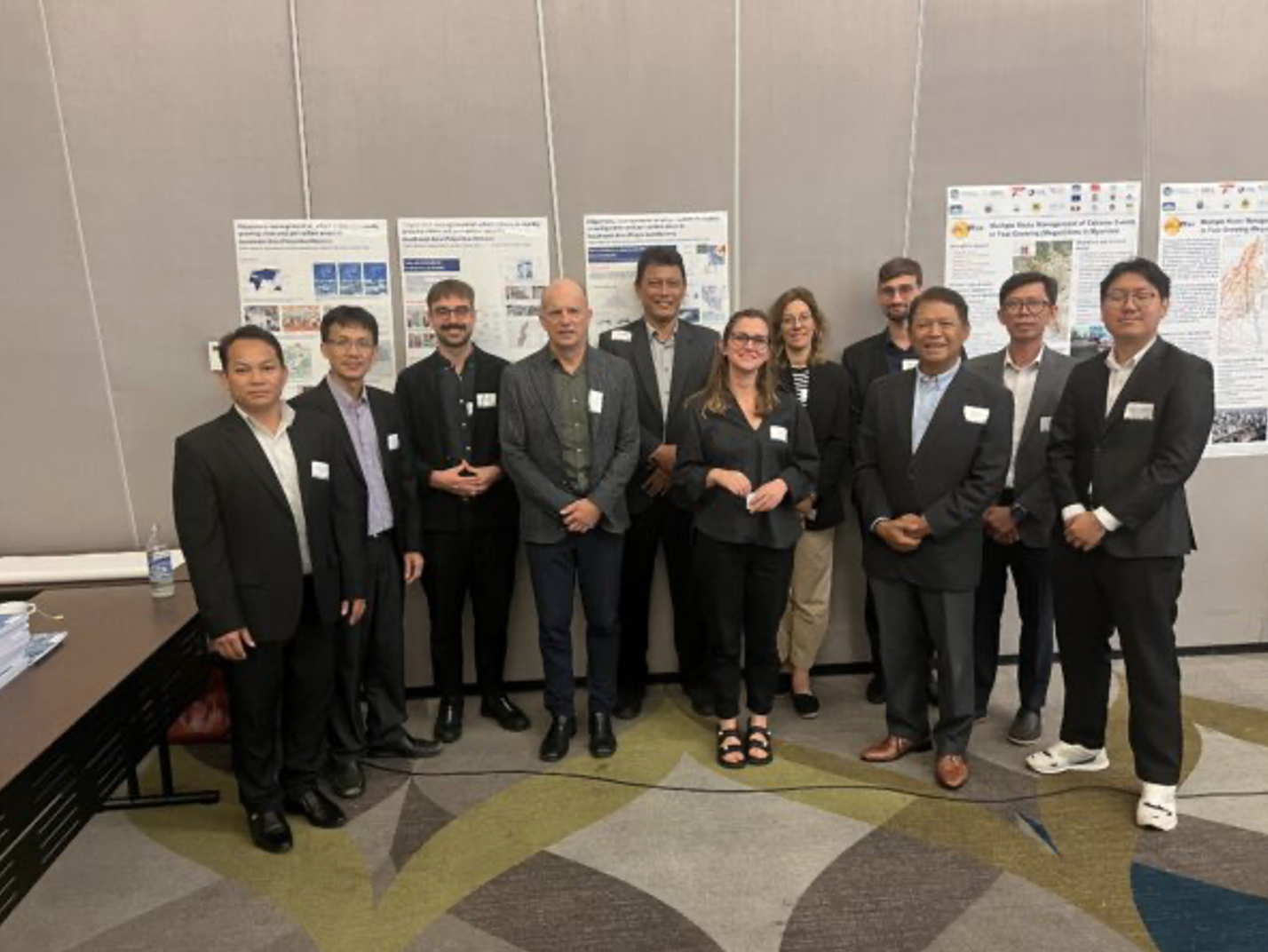
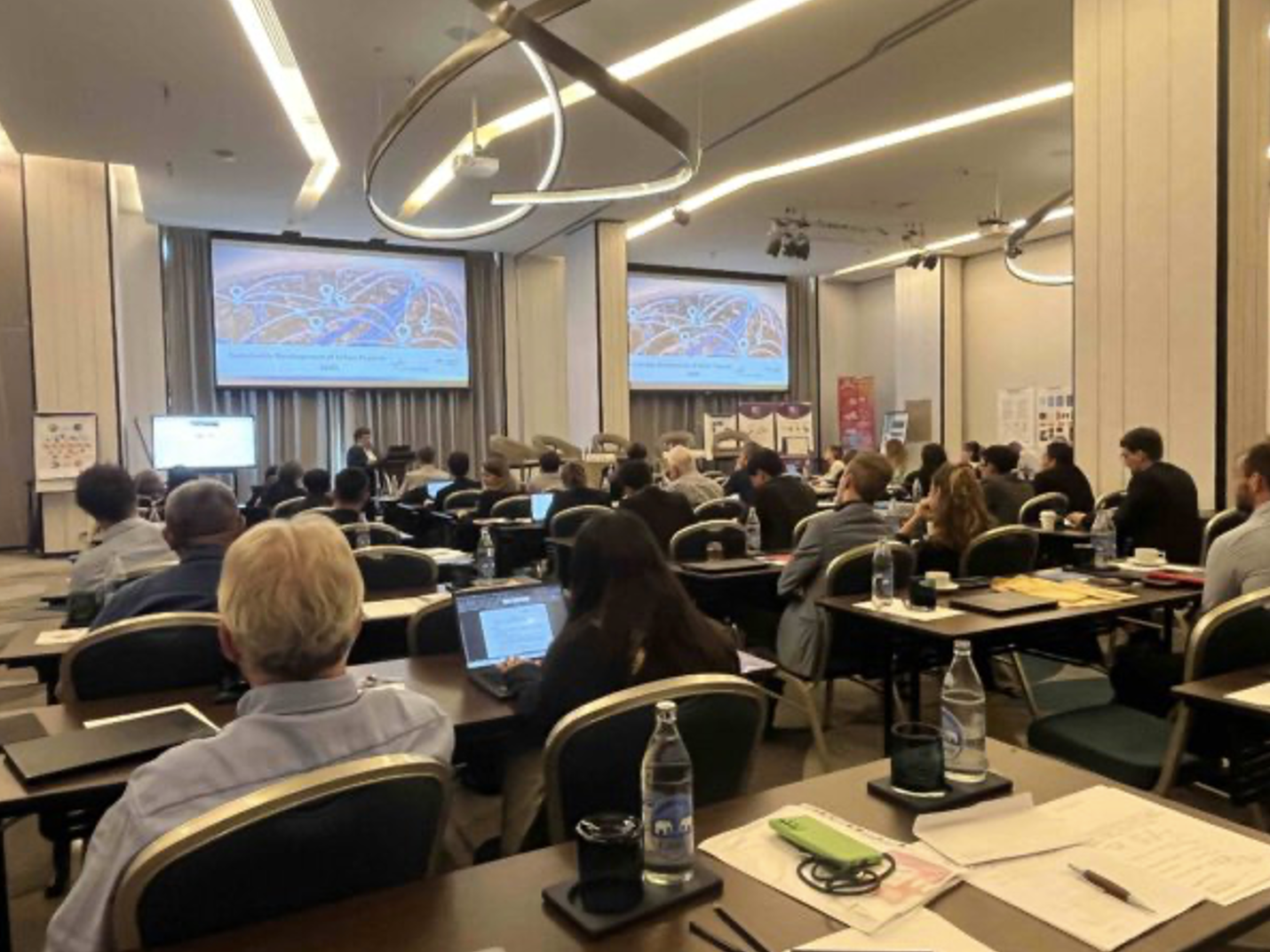
28 September 2023
PolyUrbanWaters – members participation in the Bangkok Conference of BMBF funding line “Sustainable Development of Urban Regions”
From 25 to 28 October, members of the PolyUrbanWaters network participated in the conference organised in Bangkok by the Federal Ministry of Education and Research, Germany-funded research priority “Sustainable Development of Urban Regions”. PolyUrbanWaters is one of 10 projects funded by this line.
PolyUrbanWaters was represented by members from Cambodia, Germany, Indonesia, Laos, Thailand and Vietnam. Important results of this conference show that in the face of rapid urban transformation and climate change, “water” is rapidly gaining importance as a cross-sectoral issue of urban development. And how cities are struggling to find effective responses to these challenges.
The approaches and tools developed by PolyUrbanWaters are now increasingly being applied in the partner cities of Kratié, Sam Neu and Sleman.
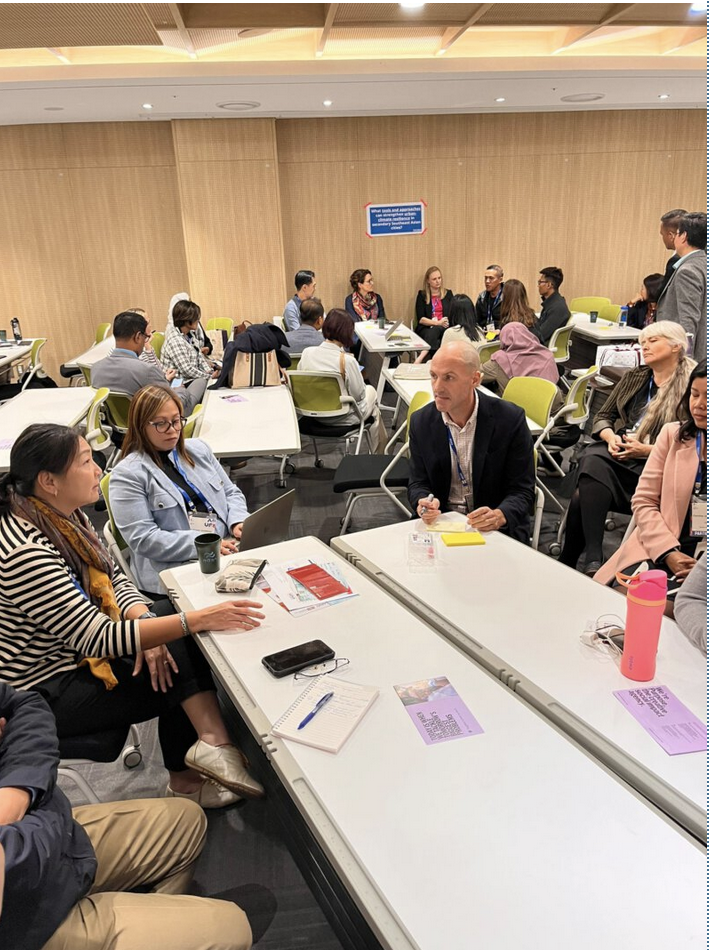
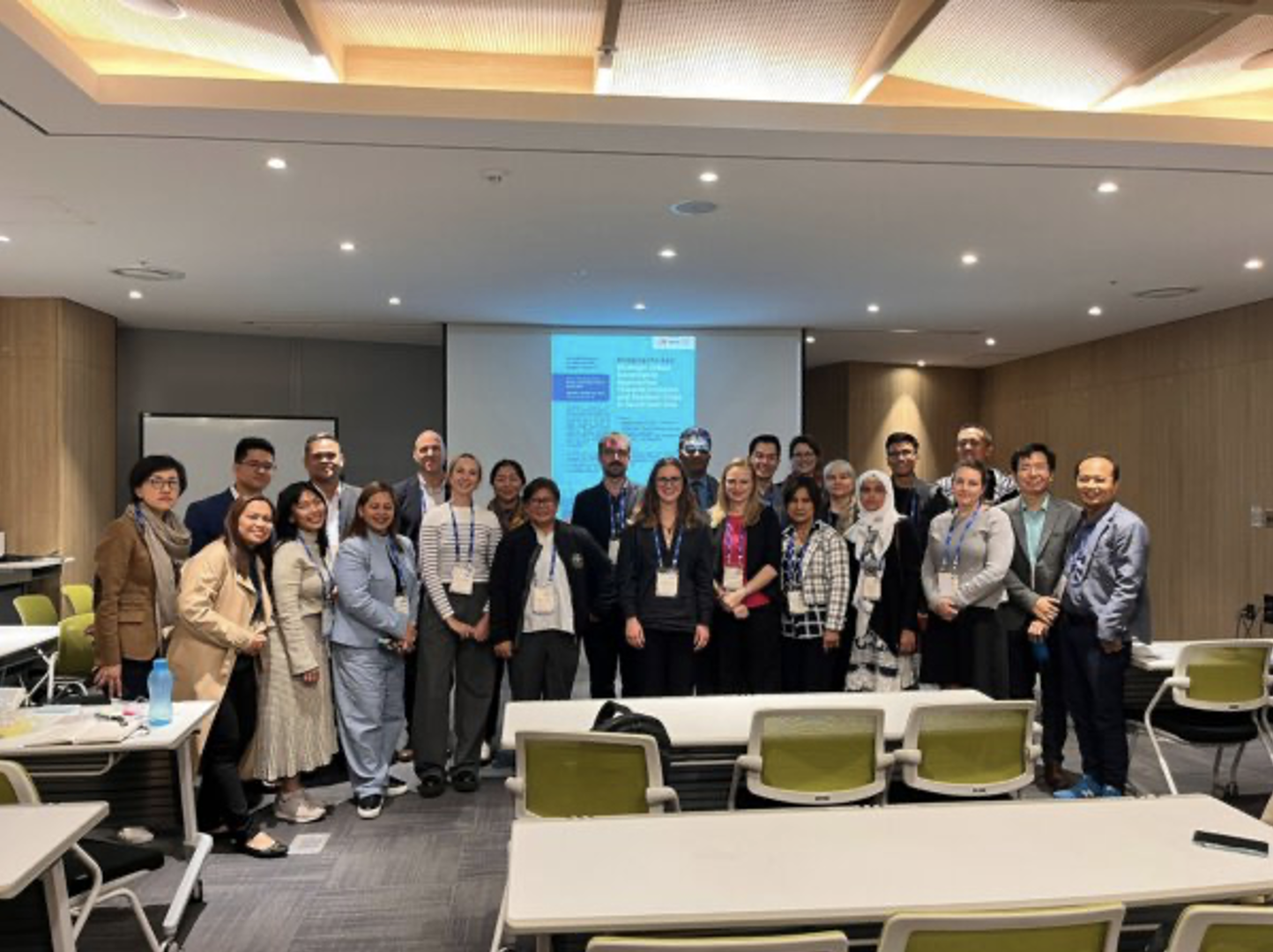
23-25 October 2023
Unveiling the Power of Water-Sensitive Urban Design: Insights from PUW at 8th Asia-Pacific Urban Forum (APUF-8)
The PolyUrbanWaters (PUW) project experiences and learnings were presented as part of discussions linked to the 8th Asia-Pacific Urban Forum’s (APUF-8) theme “Reforging Post Pandemic Pathways to Sustainable Urban Development in Asia-Pacific”. This conference was held between 23 and 25 October 2023 in Suwon City, Republic of Korea. It was co-organized by the United Nations Economic and Social Commission for Asia and the Pacific (ESCAP) and Suwon City, in strategic partnership with the Ministry of Land, Infrastructure and Transport of the Republic of Korea, and in cooperation with UN-Habitat, Habitat for Humanity International and CityNet as well as many supporting partner organizations. (Source: https://www.unescap.org/events/apuf8)
The PUW’s Cambodia Coordinator and project partners participated in two separate sessions:
Session 1 – A planetary approach to resilience, social and natural inclusion in urban revitalization of post-pandemic Southeast Asian cities organised by RMIT University Vietnam
Session 2 – Bridging the Gap: Strategic Urban Governance Approaches Towards Inclusive and Resilient Cities in South-East Asia organised jointly by Habitat Unit, Technische Universität Berlin (Germany) and Kota Kita, Indonesia
The sessions were very well received because both focused on the practical nature of the implementation of water-sensitive urban design in the context of secondary and tertiary cities in South-East Asia. One outcome from both sessions is the crucial role that management of existing nature-based solutions (NBS) will have for cities that lack substantial resources.
1 April 2023
Vision Building and planing process for a water sensitive Sam Neua/Laos initiated
As outcome of the Base Line Assessment and its strategic recommendation the local and provincial government in Sam Neua requested to start a process to apply the PolyUrbanWaters approach in two villages that are exposed to rapid transformation towards an urban area. Strong investments in residential homes are observed barely following urban planing guidelines. The interest of government agencies is to ensure a proactive planing and its implementation that ensures
- a multi-functional use of the areas (residential and commercial uses, public spaces, community facilities, etc.),
- a strong resilience against increasingly emerging flood events and mud slides and
- an effective provision of water related public services.
With support of the PolyUrbanWaters team, representatives of government agencies and village leaders identified existing and upcoming vulnerabilities of the areas. Out of this analysis, potential fields of interventions have been identified such as protection of green areas that may serve as water buffer zones, areas that may be developed as green public spaces, integrated approaches for strom water management, establishment of zones not suitable for construction because of related risks, establishment of zones for protection of fresh water resources.
Identification of potential fields of watersensitive interventions
- Rapid deforestation and land use change of paddy fields result during rainy session into rapid drainage of stormwater threatening not only families living and the narrow valley but the whole city. Protection of upstream strategic green areas, the establishment of water retention bassins and the relocation of residents to less vulnerable zones have been envisaged. (mpg-movie)
- Water pollution: Rapid urbanisation without adaquate waste water management infrastructure (today observed in city/town center) may be observed in near future in the villages and extension areas too. (mpg-movie)
- Assessing water erosion induced risks for settlements of poorer sections of urban population. The high risk exposure of the settlements is evident. Relocation of residents is urgent to avoid impacts on lifes and assets. (mpg-movie)
- Assessing needs for proactive development of water related infrastructure: Curently, in new extension areas infrastructure development follows construction activites. This practice lead to significant gaps of water related basic needs services. It is envisaged with the elaboration and implementation of detailed urban planing guidelines, these shortcomings of water infrastructure development can effectively be addressed.
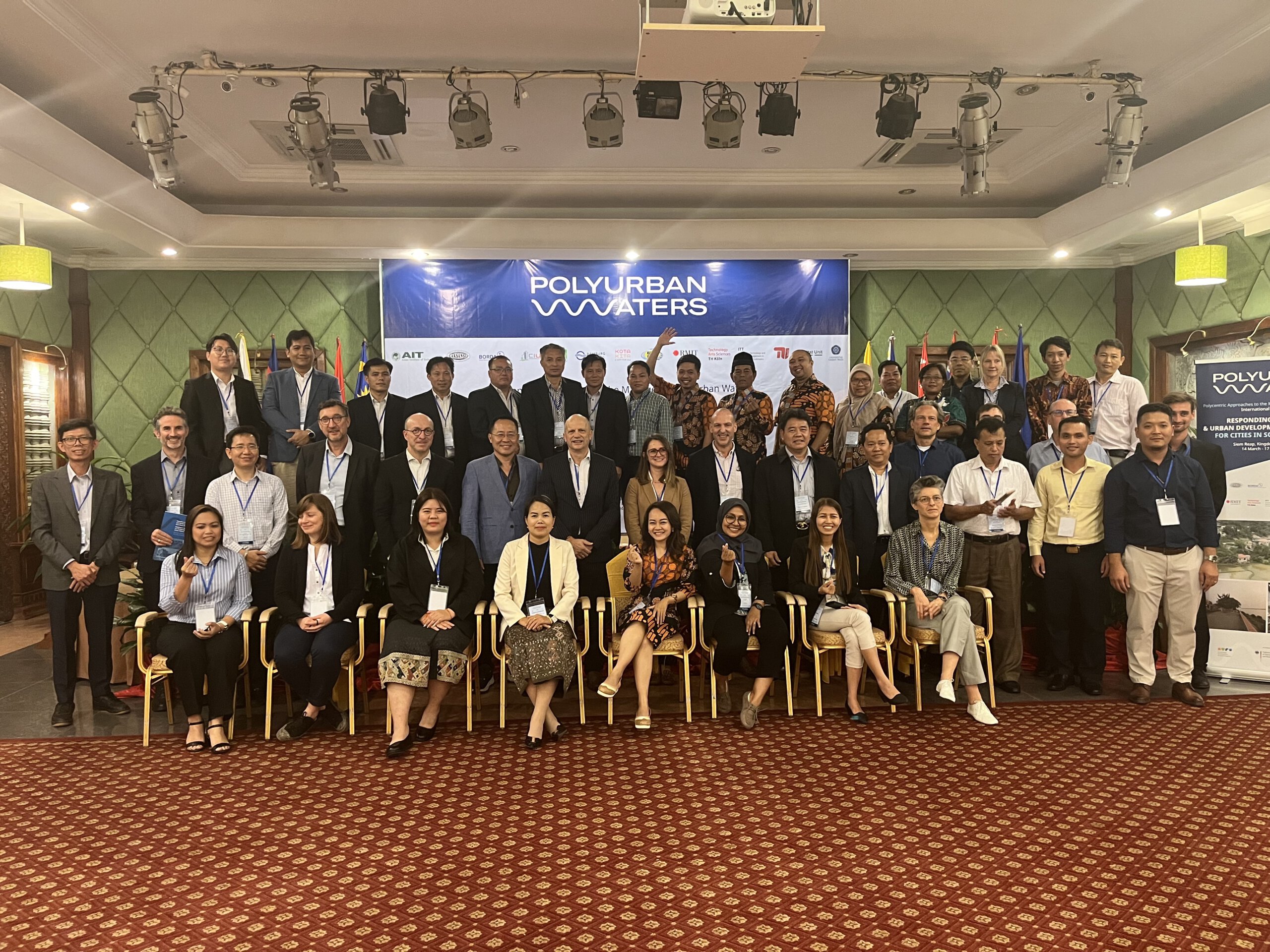
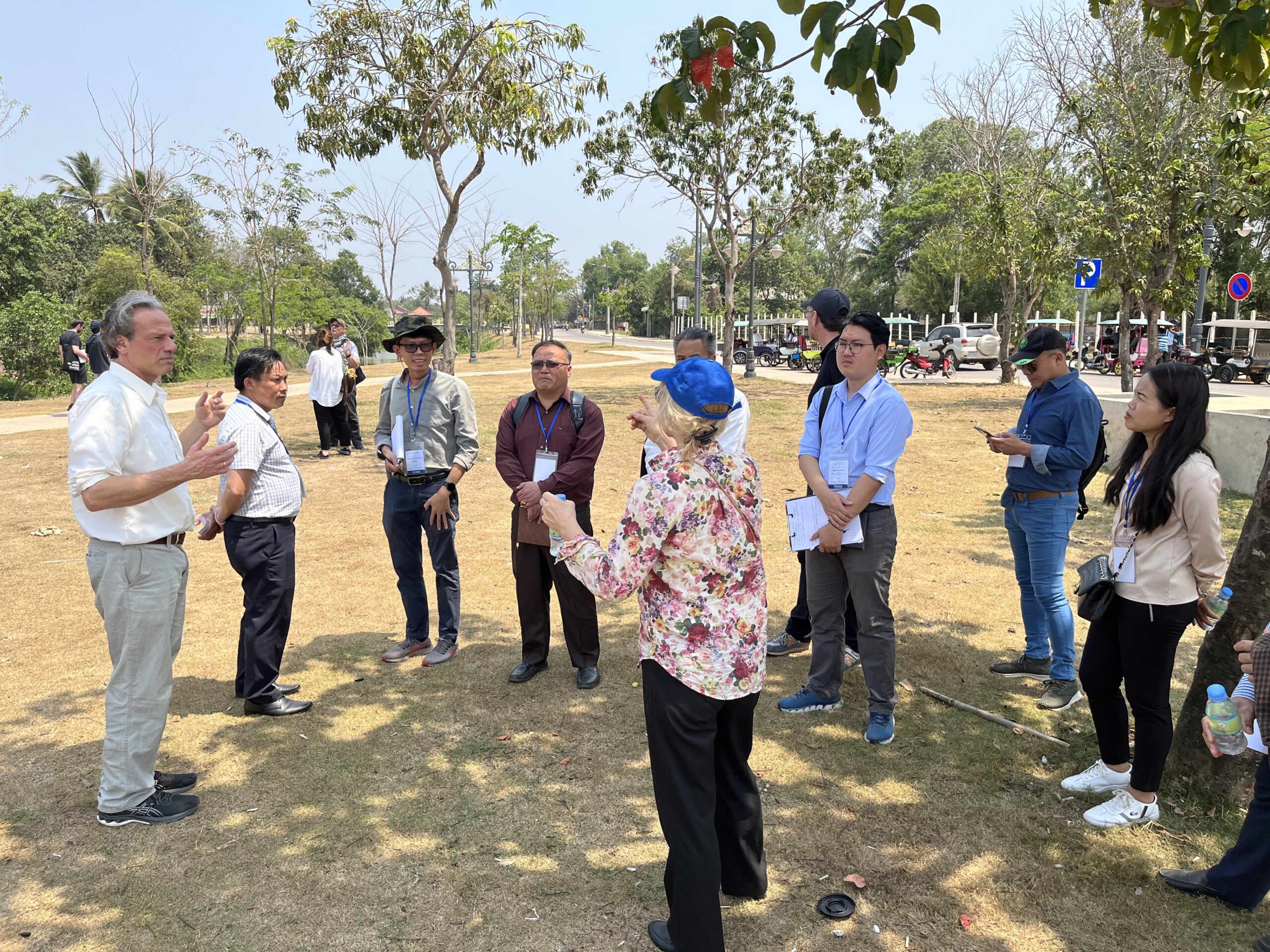
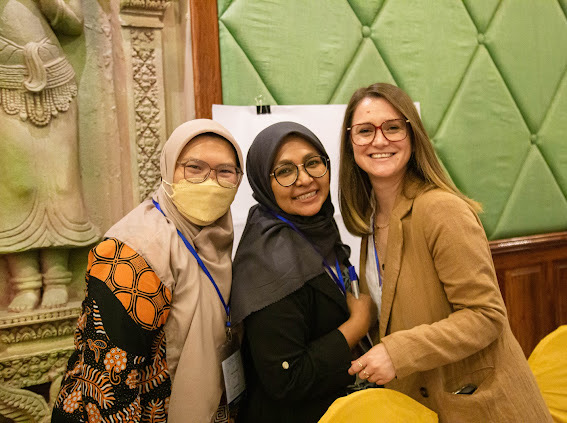

23 March 2023
International Symposium Siem Reap – Evaluating crucial project results and elaborating road map ahead towards water sensitive partner cities
From 14 to 17 March 2023, the PolyUrbanWaters – Symposium was held in Siem Reap/Cambodia.
It brought together the research network with more than 50 representatives of partners from Cambodia, Germany, Indonesia, Laos, Thailand and Vietnam. Siem Reap was chosen as the venue for the symposium because the government has made considerable efforts in urban development in recent years and the relevant experience could be brought into the discussions at the symposium.
Key outcomes of the symposium were:
1) The partner cities Sam Neua/Laos and Sleman/Indonesia formulated first strategic steps for a water-sensitive transformation of their urban areas.
2) For Kratié/Cambodia, the approach for sustainable management of the peri-urban wetlands was adopted by the local government as central for a climate change. adaptation and economic development strategy of the city
3) Visioning in the partner cities for a water-sensitive transformation, starting in March 2023, will be concretized through specific interventions at the district/neighborhood level.
4) The corresponding urban development vision is to be based on the transformation towards productive and livable cities, which is increasingly desired by the inhabitants of small and medium-sized cities in Southeast Asia.
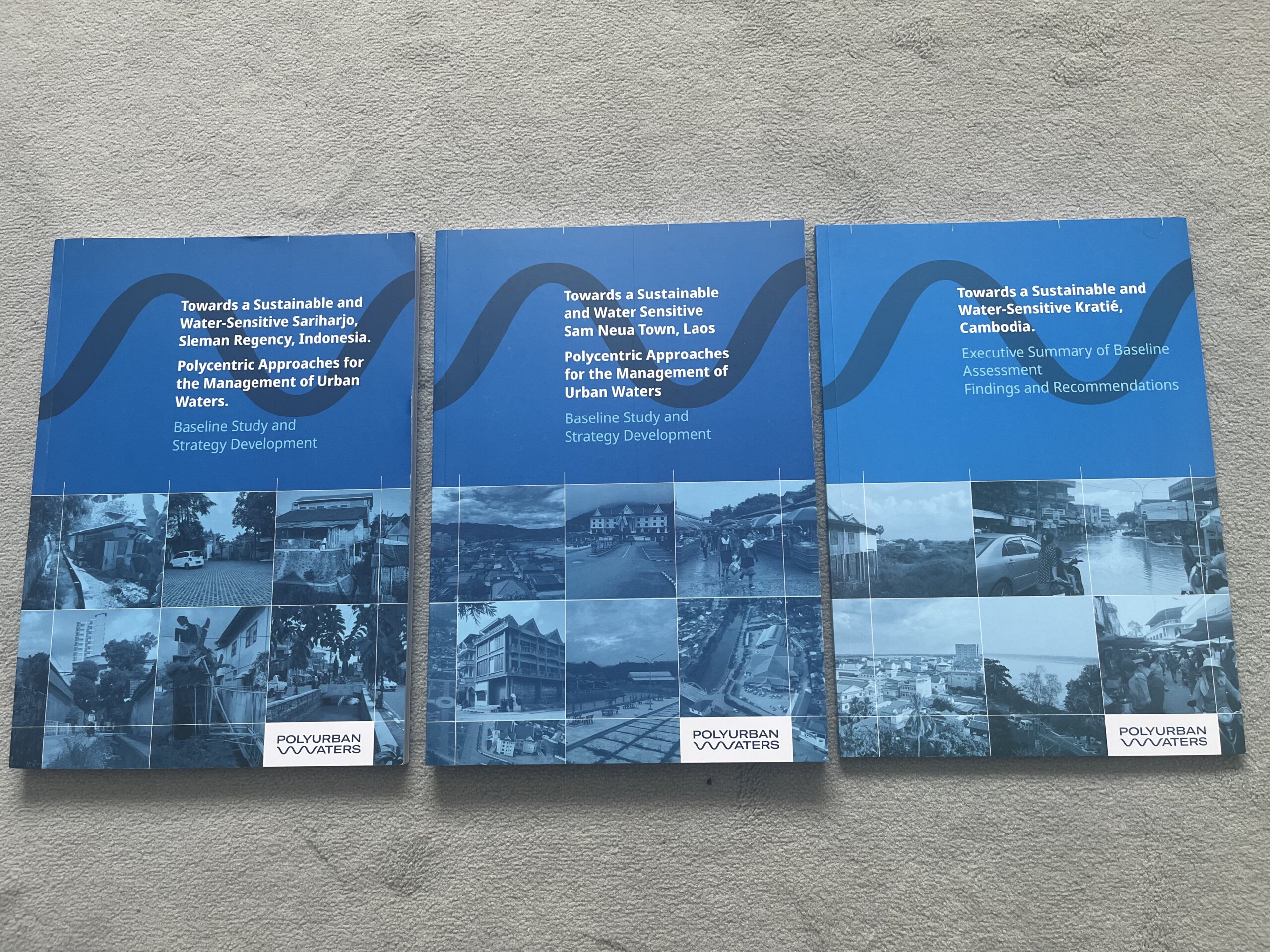
17 March 2023
Baseline Studies for Partner Cities of PolyUrbanWaters published
After two years of intensive cooperation between the partner cities Kratié/Cambodia, Sam Neua, Laos and Sariharjo, Sleman/Indonesia and the PolyUrbanWaters-Network the baseline studies could now be published.
These assessments show the water challenges of the cities in the context of an increasingly dynamic urban development, comprehensive land use changes in the water catchment and climate change.
The assessments, which also reflect the expected urban development trends in detail, are the basis for strategic recommendations for municipal and provincial administrations. The Houaphan provincial administration has already designated the study for Sam Neua as a strategic document for urban development.
The base-line studies can be downloaded from the "resources" section of this website.


28 November 2022
National Stakeholder Workshop in Laos to present the key findings of the draft of the baseline study and initial strategy development
Last week, from the 22-25th of November, the PUW Team organized meetings in Vientiane, Laos PDR with the Project Implementation Committee (PIC) comprising national government representatives from:
- the Ministry of Public Works and Transport - Department of Housing and Urban Planning as well as the Department of Planning and Finance;
- Public Works and Transport Institute;
- Project Coordination Unit of the Greater Mekong Subregion Project.
And local level representatives from:
- the Department of Public Works and Transport;
- Development and Administration Authority;
- Department of Natural Resources and Environment, and Provincial and District Offices of Houphanh and Sam Neua;
- Sam Neua Water Supply State Enterprise.
The aim of these meetings was to present and discuss key findings of the draft of the baseline study and initial strategy development. Additionally, an example activity on cross-sectoral urban planning was carried out with partners, focused on urban planning and urban water management needs within an urban extension area of Sam Neua Town. The activity gave participants an opportunity to localise key findings of the baseline study and initial strategy development phase and gain a deeper understanding and appreciation of the different requirements and perspectives of the respective participants/sectors concerning the focus area.
A key outcome was listing core capacity development needs for stakeholders and tailored capacity building support possible. The project´s upcoming vision-building and capacity-development activities will be based on the key findings generated during the discussion sessions.
Overall, it was an engaging and productive week, where interdisciplinary project partners of the Project Implementation Committee became more aware of each other's current and future challenges, opportunities and optional strategies to confidently face the expected consequences of urban growth and climate change in order to achive their vision for a Green, Clean and Beautiful Town.
Selected recommendations from the process until November 2022 are:
1) Given the topopgraphic condition of a narrow valley and rapid change in land use patterns throughout the water catchment area, increasing soil sealing and loss of green areas (such as conversion of rice paddies to building land and forest cover) is creating increasing vulnerability to flooding. This should be countered by the development of hybrid gray-green infrastructure (water retention basins, infilitration areas, or other nature-based solutions).
2) To date, the expansion of the urban area has followed the development of the road network in a largely unplanned manner. That is, water-sensitive infrastructure development (drainage systems, water supply, etc.) follows increasingly intensive construction activity. Participatory urban planning should proactively ensure effective infrastructural development and especially the development of public green spaces (community facilities, sports fields, etc.).
3) The increasing pollution of water bodies is largely due to the absence of any wastewater management system. The mandatory implementation of septic tanks and DEWATS systems especially in new buildings and the successive upgrading of the existing building stock. The establishment of an effective sludge management system will be highly dependent on consistent monitoring and law enforcment by the local government.
The complete base-line study will be available soon in the download section.

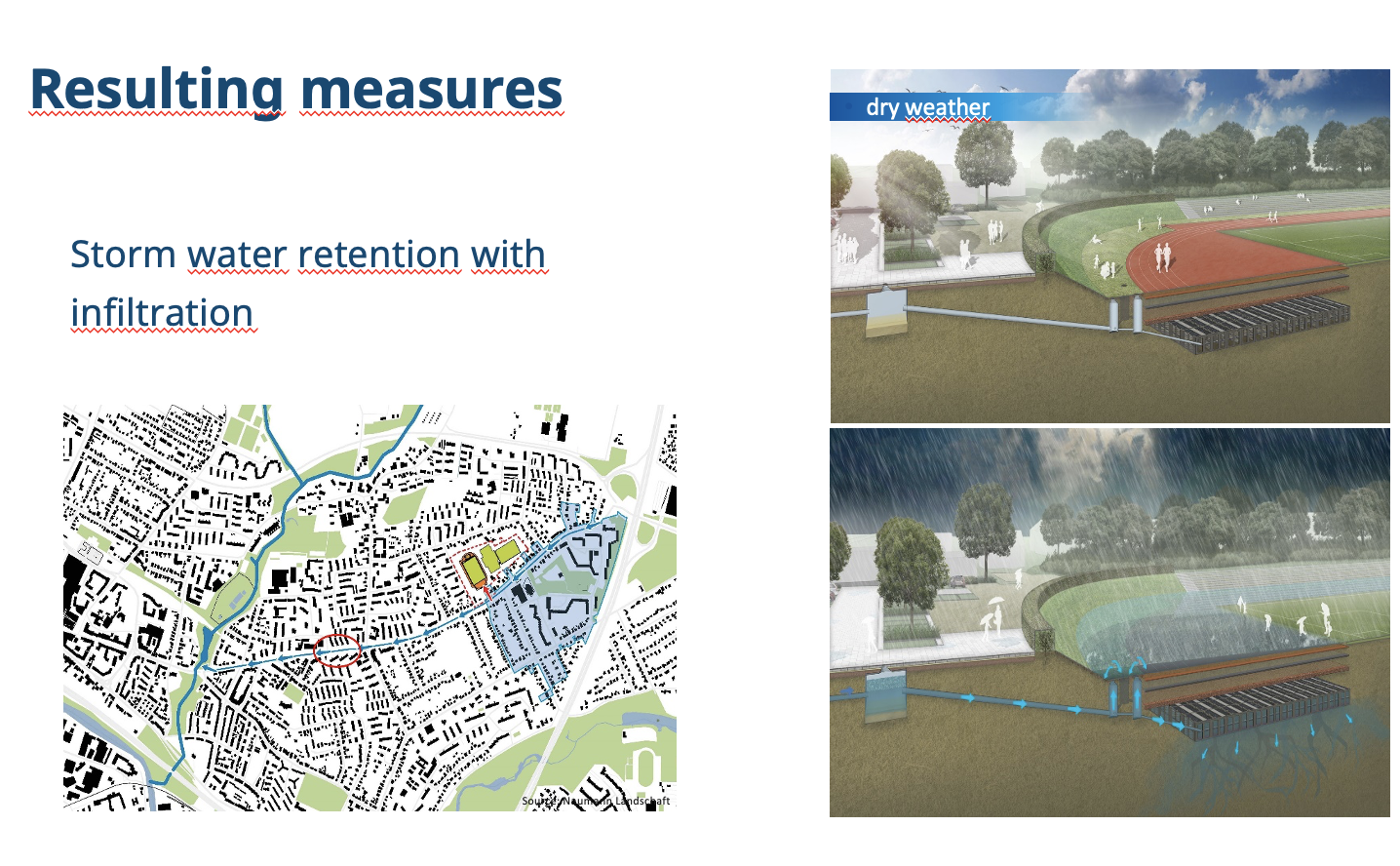
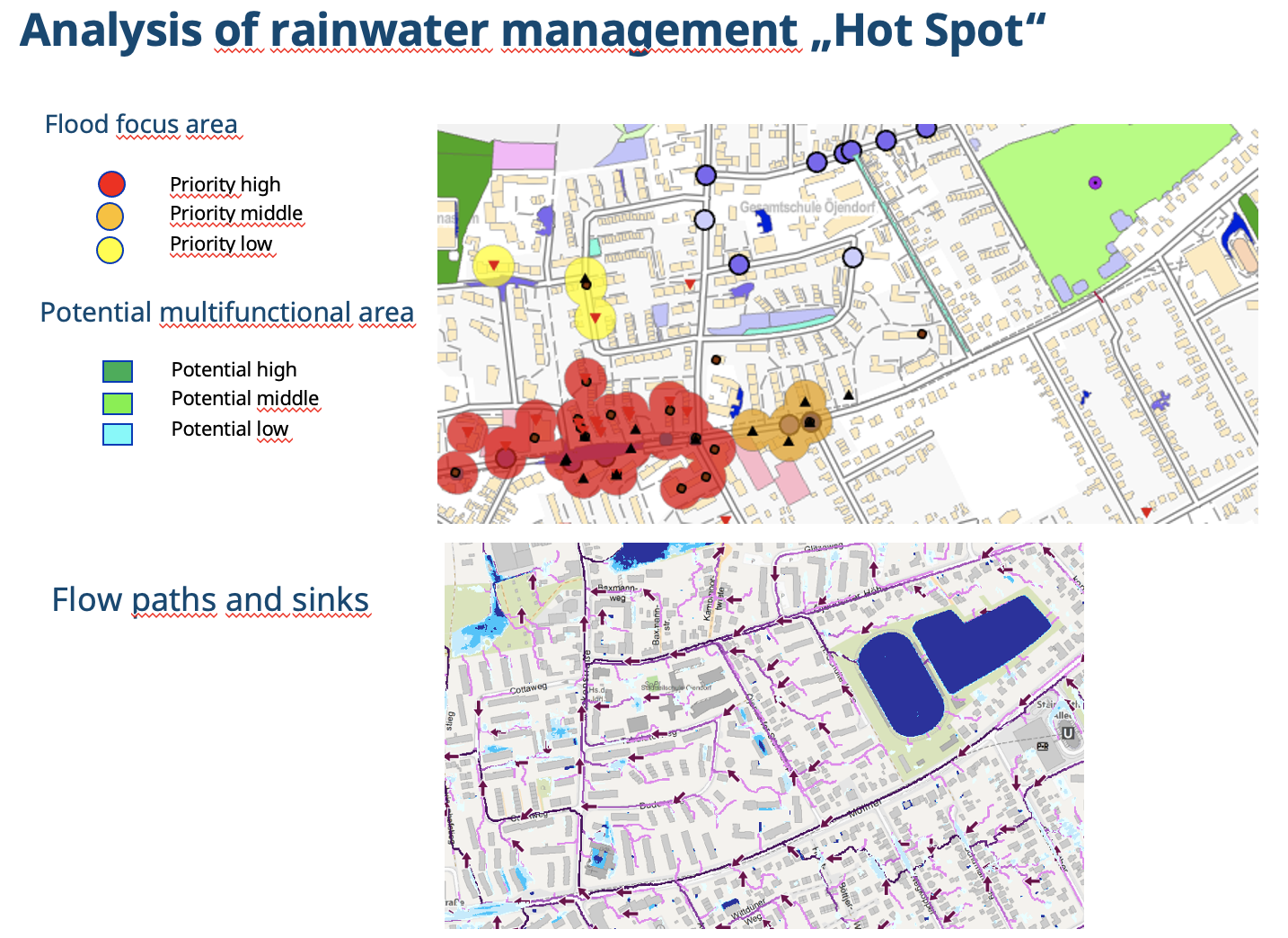
24 November 2022
Project Update 16 Integrated Stormewater Management - learnings from Hamburg/Germany
Linnea Foelster Hamburg Wasser/German Water Partnership shares with a national experts experiences of integrated stormwater management in context of water wise city development of Hamburg.
The regional ministry is planing an urban development to modernise a big area and to construct houses for > 5000 people.
After receiving the first vision of the urban development, the water operator HAMBURG WASSER investigates about the water, waste water and rain- and stormwater situation and needs.
1) After a comprehensive analysis of stormwater hot pots,
2) flow regimes of strom water is detected.
3) Multifunctional areas are identified were storm water can be drained and in the same the key prurpose such as sport activities can ensured.
4) Effective, attractive architectural and technical design contributes sgnificantly to the livability of the city.
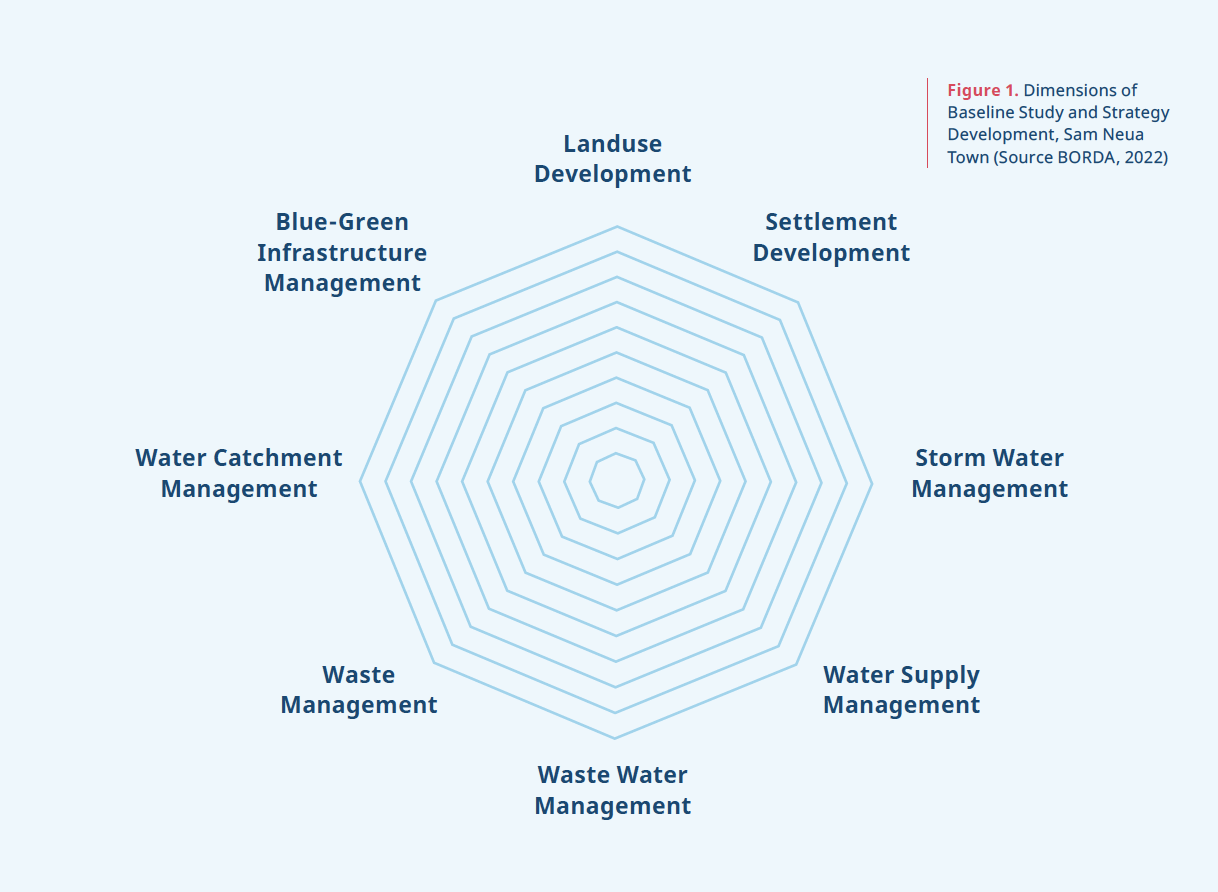
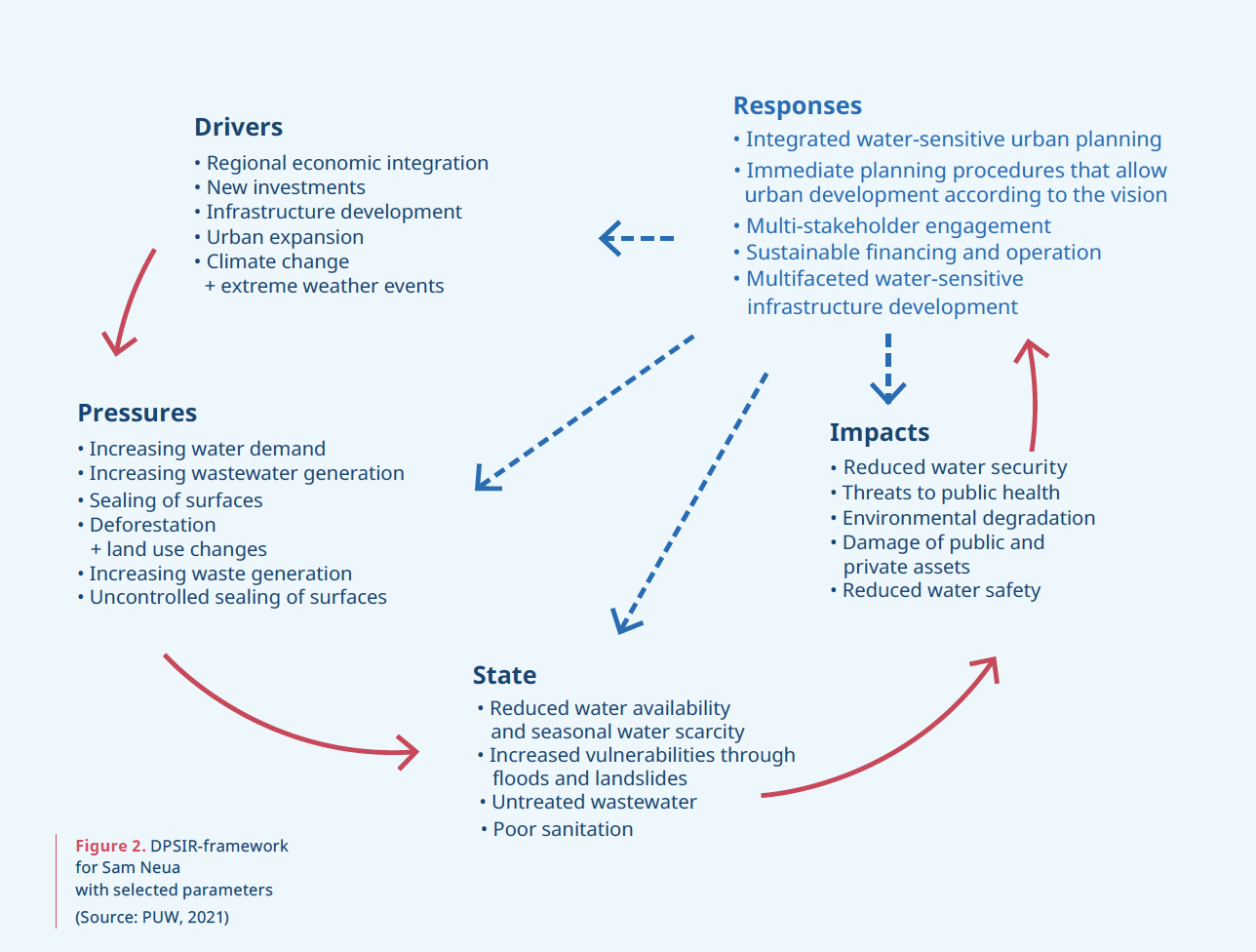
15 October 2022
Project Update 15 Conceptual and analytical approach for the polycentric management of urban waters sucessfully tested.
The comprehensive baseline assessments for the partner cities Sam Neua/Laos and Sarihajo/Sleman/Indonesia are now available (both documents will be accessible in the download area from January 2023). These studies and the strategy recommendations elaborated in them are based on analyses of the socio-economic and natural change dynamics to which the cities are exposed and the resulting urban planning and water management challenges.Here, the DPSIR framework has proven to be a robust tool: Driving forces such as demographic, economic, social and climate change
induced causes of urban transformation may translate into pressure on
water and natural resources, such as higher water demand. The state of water
resources is captured by information on water quantity and quality and overuse
of natural water resources that may have an impact on public health and
ecosystems. Improved land use planning and infrastructure development may
be appropriate responses to mitigate pressures and to achieve development
targets.For a detailed analysis, the PolyUrbanWaters project has developed a polygon of water-sensitive urban development. “Water” is elaborated with this tool as a cross-cutting issue of sustainable urban development. In this way, the dimensions of urban planning and water management challenges in Sam Neua and Sarihajo/Sleman could be specified as a cross-sectoral task and solutions corresponding to local capacities could be worked out.
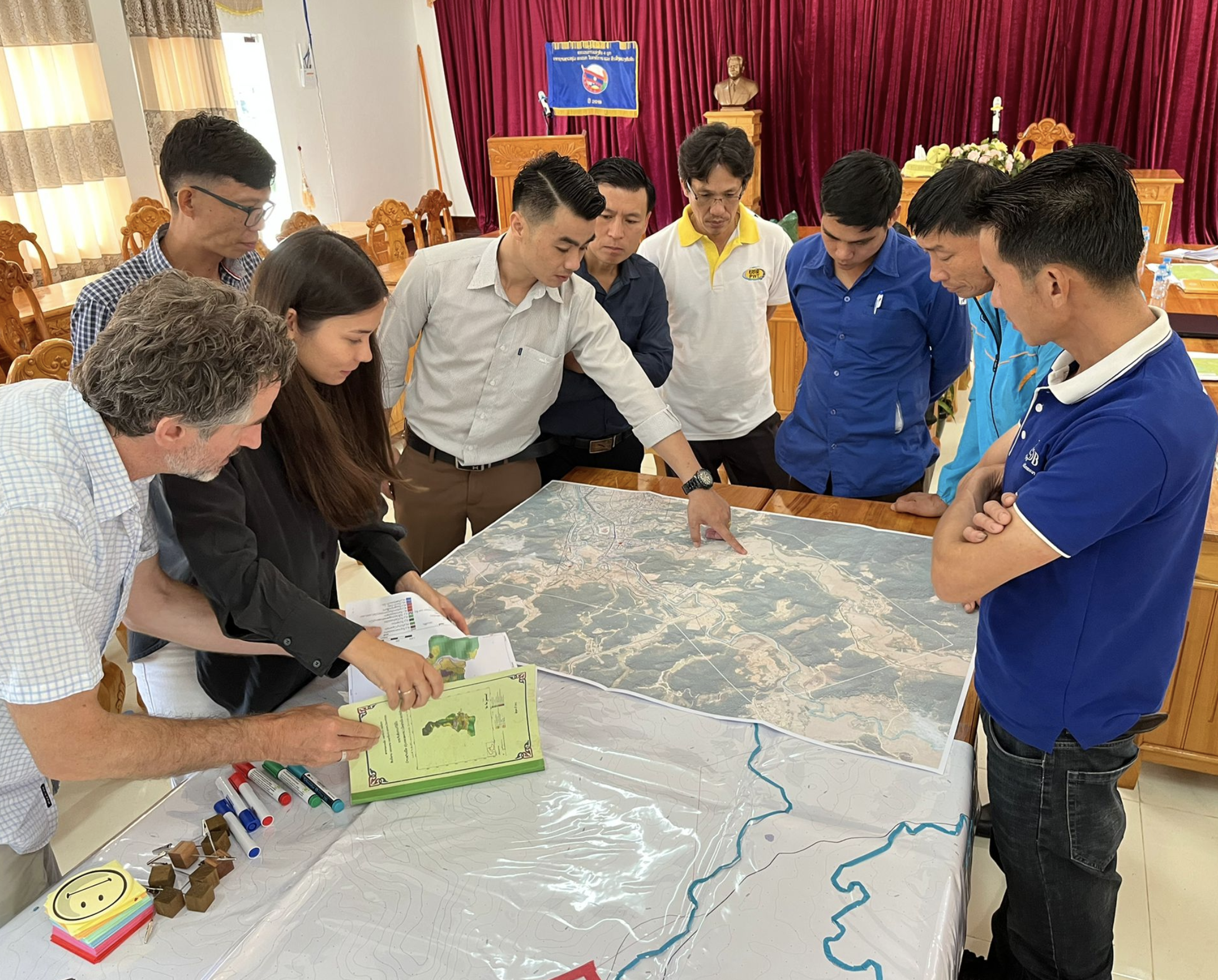
10 July 2022
Project update 14 – Planning in Sam Neua
The PolyUrbanWaters research team with members from Laos, Thailand, Cambodia and Germany conducted extensive research in Sam Neua with the national urban planning authority Department of Housing and Urban Planning (DHUP) and Public Works and Transport Institute (PWRTI ) and the local/provincial/district government from 18 to 26 June 2022. Among other things, an analysis of the flood vulnerability of the city itself and the urban catchment area was carried out. In this context, research results obtained in the context of the base-line study “Water in the city of Sam Neua” could be verified and significantly deepened: 1) The topographical profile of the city area, which is located in valleys with steep slopes, and its peri-urban areas, which are still strongly characterised by agriculture, is per se exposed to a strong runoff regime during heavy rainfall events.
2) The dynamic conversion of forest areas in the watershed into farmland significantly reduces the water absorption capacity of the soils and contributes to a further increased run-off of rainwater.3) Despite the COVID-19 pandemic, heavy construction activity in the valleys is contributing to rapid conversion of agricultural land, i.e. mainly paddy fields into settlement land. The resulting land sealing is associated with a considerable loss of infiltration areas.
4) With the higher frequency and intensity of heavy rainfall events to be expected in the course of climate change, there is a risk that the various influencing variables of the runoff regime will reinforce each other. At the same time, buildings are increasingly being built in existing and future potential flood risk zones.
5) Local stakeholders have discussed these trends in participatory workshops. Methods such as risk mapping were used. In this context, the influencing factors and the consequences of the flood disaster in the Ahr valley/Germany in July 2022 were discussed. In this valley, too, a major flood disaster seemed unlikely for decades. Land use changes, development of residential areas in risk zones and climate change induced extreme rainfalls resulted in 134 fatilities and damages worth billions of Euros.
6) The results of the research activities and dialogue events are now being evaluated with a view to developing more accurate vulnerability diagnoses and forecasts. Recommendations for action for urban and provincial government will be derived from this. The results will then be presented to government bodies at local and national level in October 2022.
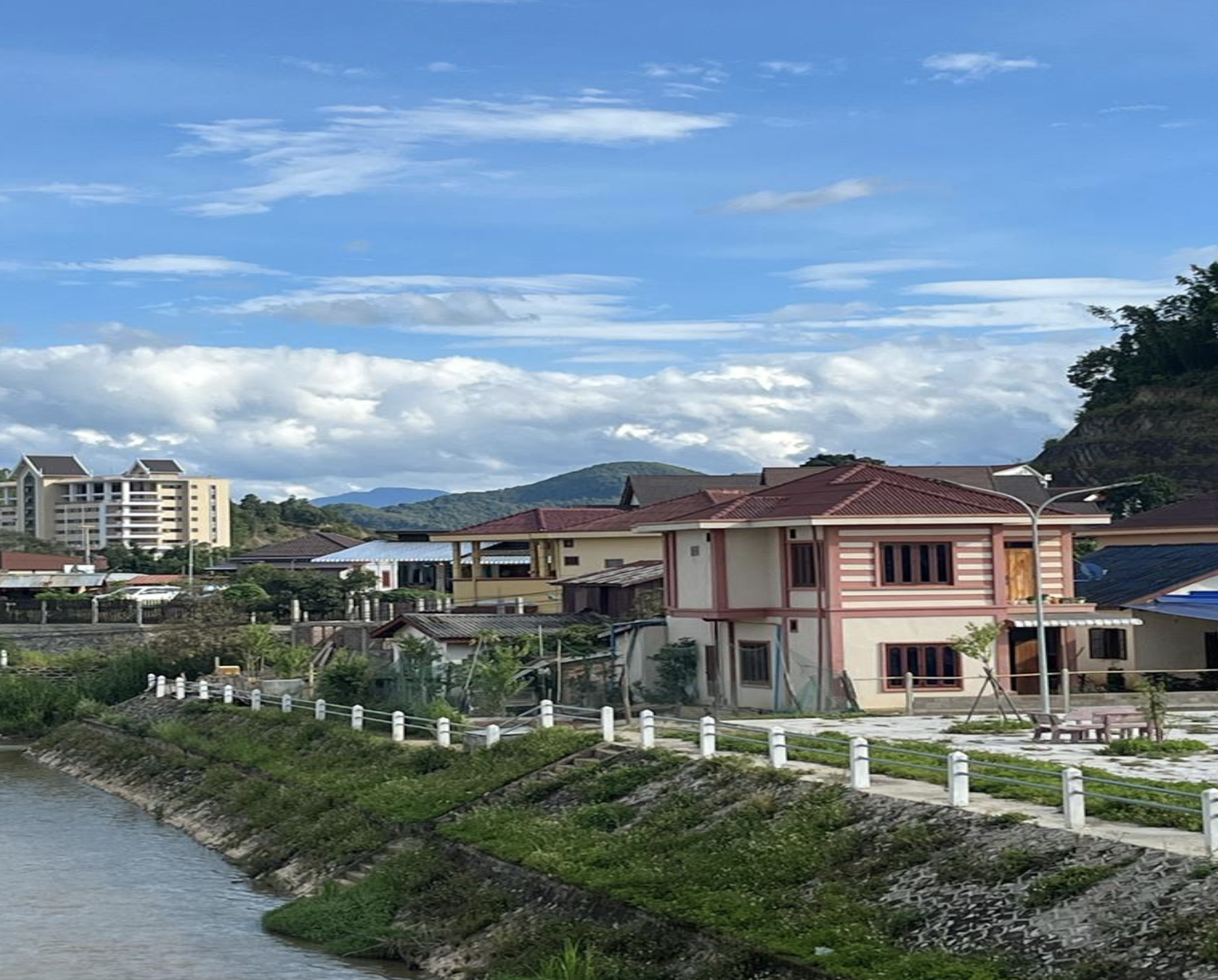
22 June 2022
Understanding water infrastructures. Participatory workshops in Sam Neua, Laos
The PolyUrbanWaters team continues its work in the field with participatory workshops, this time in Sam Neua, Laos, to discuss the current status of water in the city (based on the findings of the baseline study report). Stakeholders from various ministries and departments, as well as village leaders, met and began collectively mapping their neighbourhoods using participatory methods and tools.
Participants actively discussed the current challenges in their city, the likely consequences of urban change, and the impact on the city’s future development. Excavations, landslides, the conversion of rice fields for construction area, and finally flooding were some of the identified priority threats. Among others, the rapid development of new investments, new public infrastructures, and unguided proliferation of new housing were identified as the main drivers of urban transformation of the region. Collective mapping not only improved the data collection process, but also strengthened the capacity of participants through an inclusive, co-productive, and multi-sectoral approach to planning.
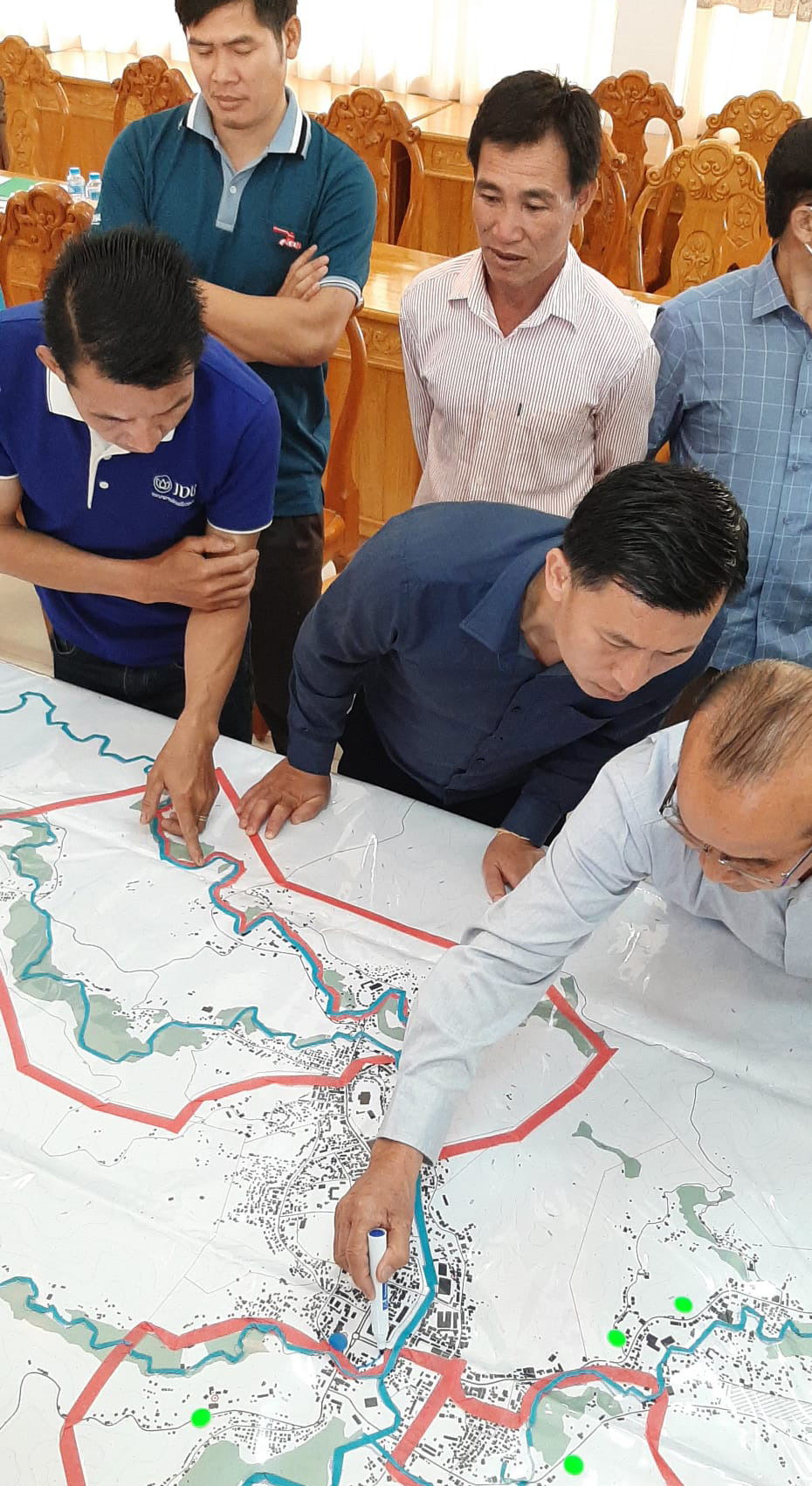
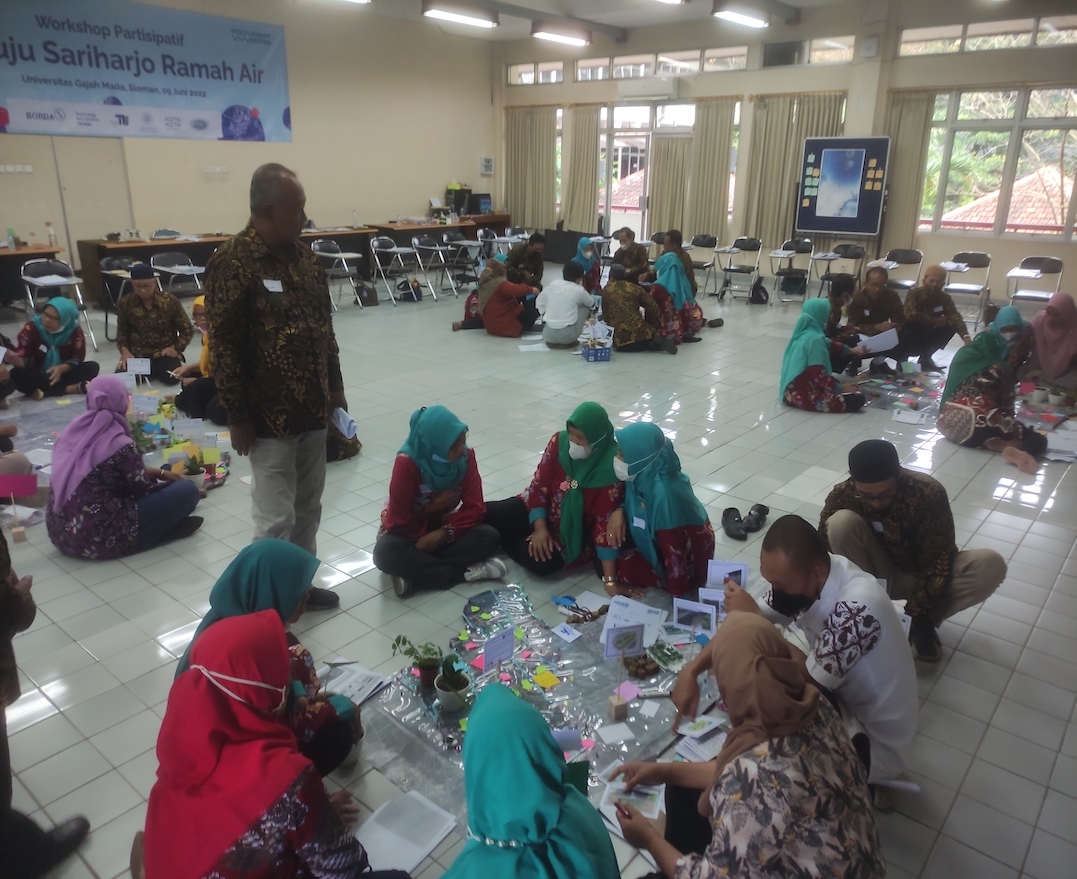
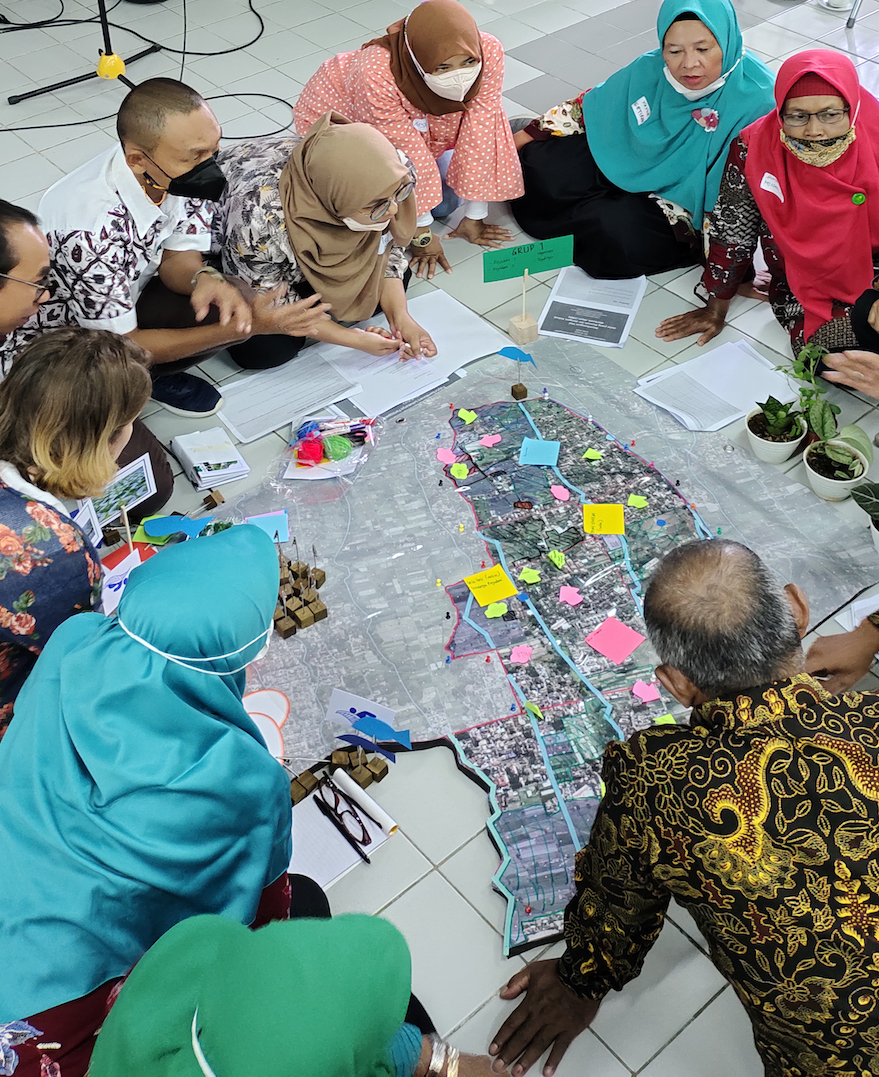
9 June 2022
Water in the neighbourhood. Building water-sensitive visions.
Participatory workshops in Sleman, Indonesia
On the 9th of June, the PUW team organised participatory workshops in Sariharjo Village, Sleman, Indonesia to discuss the current state of water in the city – based on the results from the Baseline Study Report - and to develop the first water-sensitive visions for the village. The leaders from 16 Sub-village administrations and the representatives from different local organizations, including women’s organisations, came together to engage in developing future visions for their neighbourhoods through participatory methods.
In the first workshop session, some exercises on the scenario „business as usual” were organised. The participants engaged in discussion and mapping of the current and future challenges for Selman Regency’s urban transformation and their impacts on the further development of the city. Population growth dynamics and a growing number of uncontrolled built-up areas were identified as major drivers of the region’s urban transformation.
In the second session, the participants shared their knowledge about concepts for green and blue infrastructure, water-sensitive cities and nature-based solutions (NBS). This introduction to NBS was followed by a mapping exercise with each working group identifying and locating existing and envisioned NBS. The workshop finished with a fruitful discussion on the concept of a water-sensitive city and its potential for Sariharjo Village and Sleman Regency.
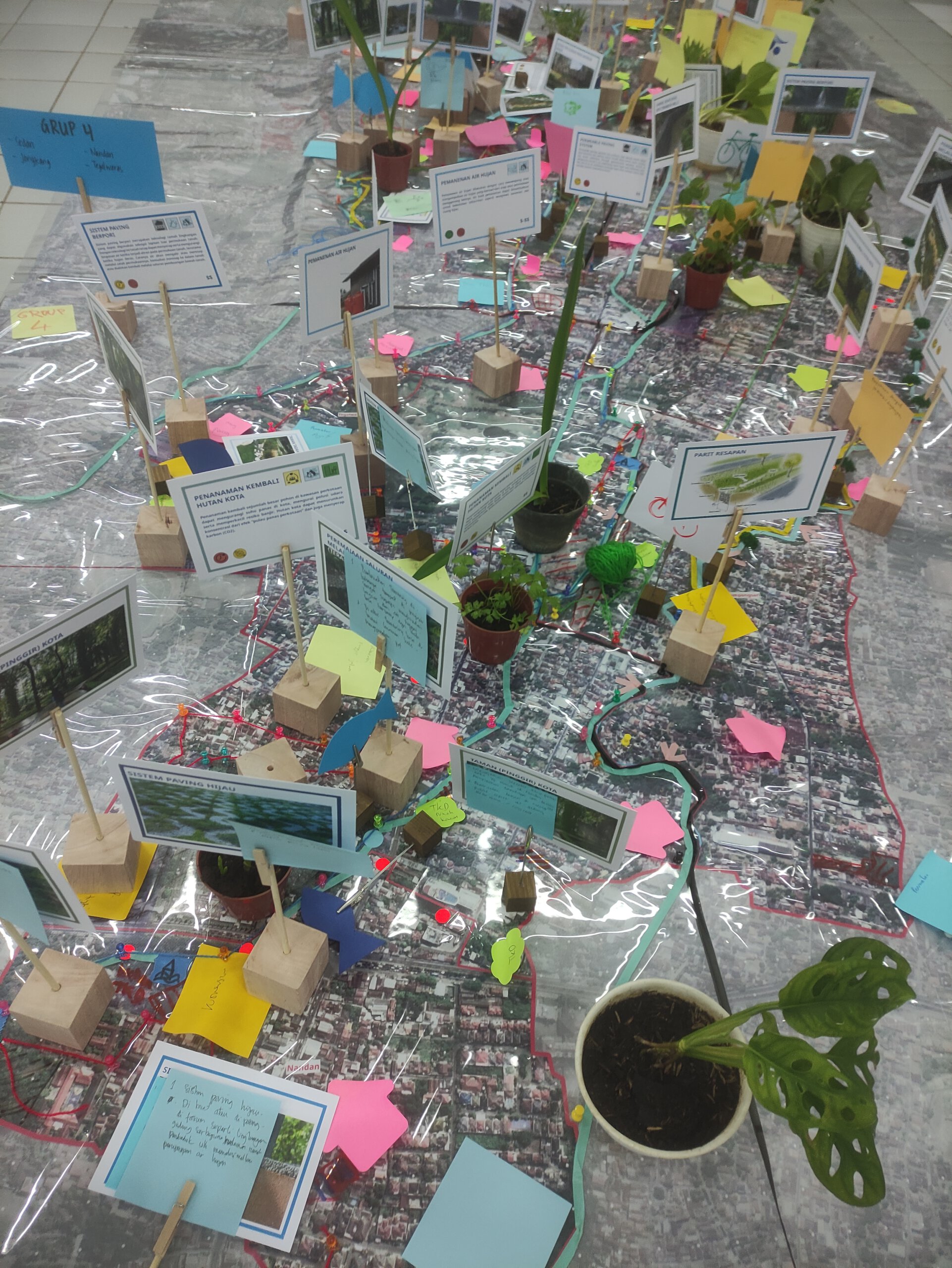
2 June 2022
Project Update 13 - Effective water services by water operators as key for SDG-oriented urban transformation.
The analyses carried out as part of the PolyUrbanWater’s baseline assessment in the urban area of Sahirajo in Sleman/Indonesia show the special challenges associated with a water supply system that is still predominantly rural in nature but is now becoming more urban. A large proportion of households in this city are supplied with raw water from private wells through largely uncontrolled extraction. This situation is not unique to Sahirajo but is characteristic of Indonesia on the whole where the low level of water supply from the water utility is a fundamental challenge to urban development and sustainable water management. With urbanization now gaining momentum in Sahirjao, there is an associated increased water consumption of new apartment blocks, hotels and commercial facilities, and this is exacerbating the risk of increasing groundwater extraction having a detrimental impact on the renewable nature of groundwater resources leading to a drop in overall groundwater levels. This trend is already being observed in the vicinity of new buildings and will need to be counteracted primarily by improved water supply through the responsible local authority. However, this authority faces a complexity of institutional challenges, particularly with regard to the financial sustainability of an efficient water supply for which regulatory enforcement and nudges must persuade water consumers to connect to a tariff-based central water supply system.
25 May 2022
Project Update 12 - The significance of paddy fields for climate change adaptation
The baseline analyses currently being carried out in PolyUrbanWaters’ partner cities indicate that issues and challenges for sustainable green infrastructure development revolve not only around planning and technical questions, but above all around their green infrastructures’ sustainable management. As a result, these questions about the maintenance and further development of existing green infrastructures are increasing in importance. In this respect, the landscape of the partner cities is like many cities in South-East Asia: strongly characterized by large areas of wet rice cultivation. These green spaces are of essential importance for the hydrology of the peri-urban zones and the core city. In addition, they have an important function in maintaining a pleasant local climate. Especially during heavy rainfall, the paddy fields act as storage, buffering or delaying the release of stored water. Furthermore, as the example of the PolyUrbanWaters partner city Sam Neua/Laos shows, the loss of paddy fields is increasingly dynamic in the course of urbanisation. Without protective or compensatory measures, such as water retention basins or comprehensive drainage systems, the city’s flood vulnerability will increase due to the accelerated runoff regime, especially during heavy rainfall events. The city administration will need to counteract this with integrated stormwater management that considers the value of existing paddy fields. Ultimately, the question will be what significance paddy cultivation will have in a changed peri-urban landscape. Taking this into account, productivity gains through sustainable cultivation should enable increased value creation and thus also an increase in the economic importance of this infrastructure. Moreover, improved cultivation methods should lead to a reduction in the over-fertilization of the paddy-fields and in the resulting pollution of surface and groundwater.
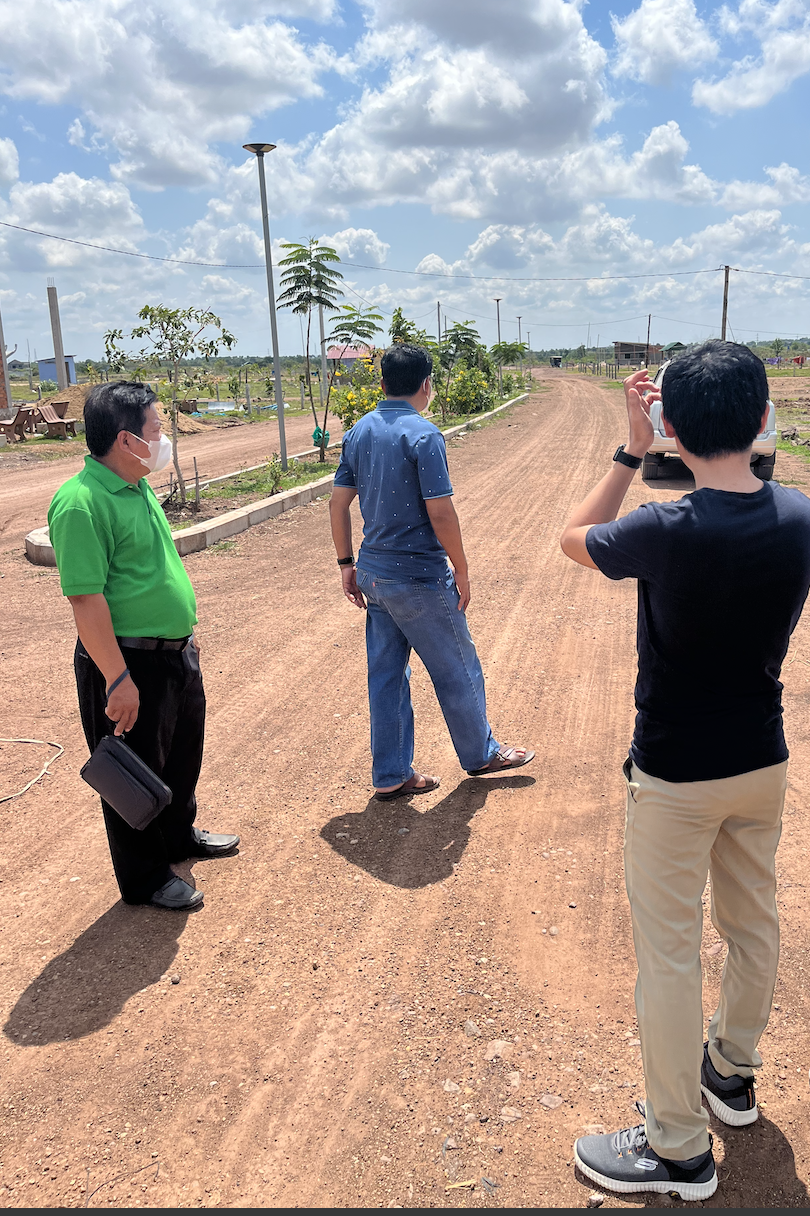
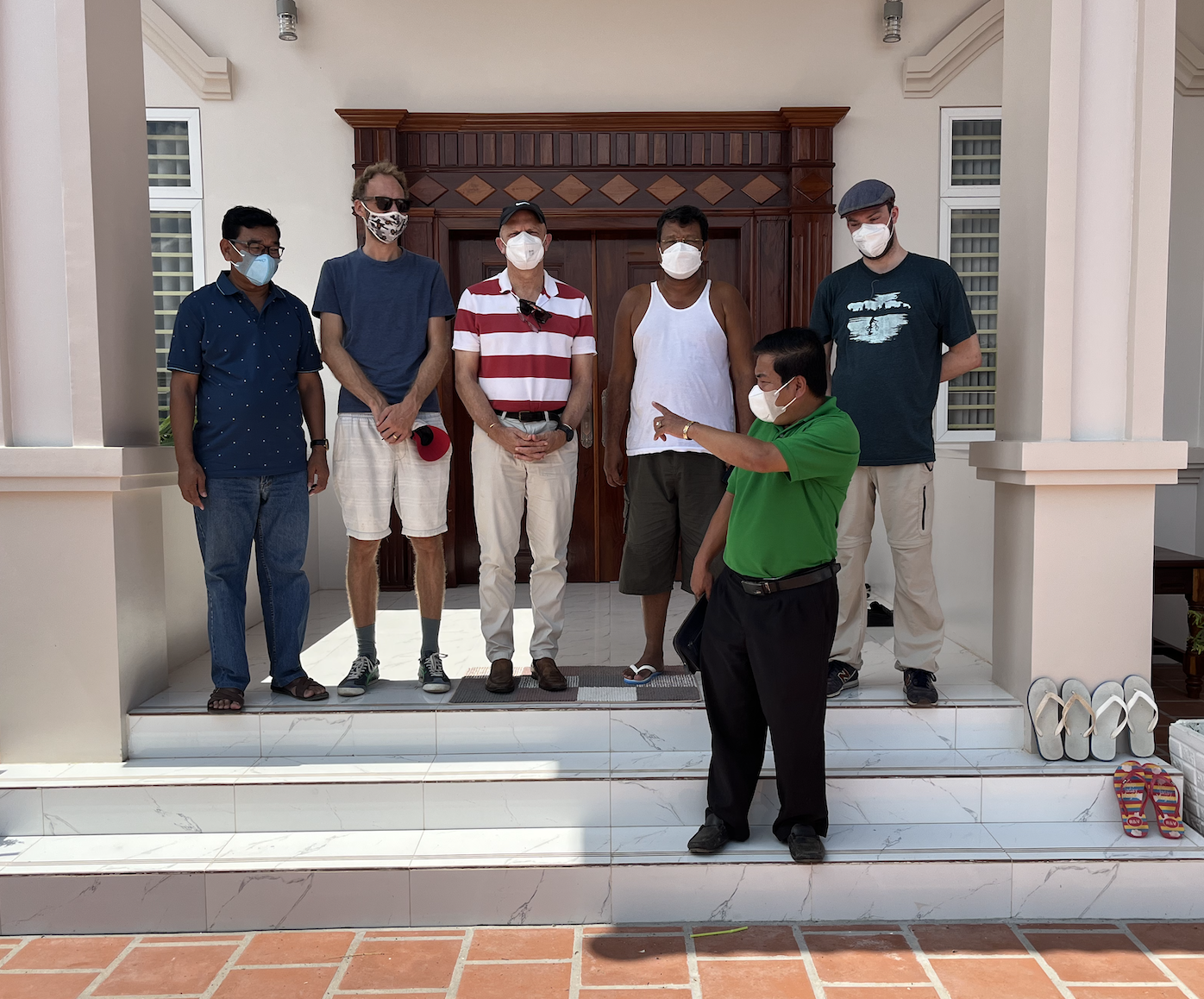
15 May 2022
Project Update 11 - Financing and maintaining green infrastructure in new urban development areas
PolyUrbanWaters reviews the extent to which green infrastructure developments can be made sustainable in its partner cities. In the course of base-line assessments, the project tries to find out to what extent the objectives and guidelines increasingly formulated by regional development banks and national governments can be implemented in the socio-economic context of secondary and tertiary cities. In the partner city of Kratie/Cambodia, for example, the hypothesis was tested that, due to the large amount of open space available, new development areas are particularly suitable for comprehensive green infrastructure development. On-site surveys have shown, however, that the development logic of new housing estates in structurally weak areas initially leaves little room for infrastructure development. Land is acquired and parceled out and then sold to interested parties, who only gradually build on the land. Infrastructure development (water supply, drainage, etc.) then often follows with a time lag, when funding is made available by the state or the buyers/investors. Green infrastructures usually require intensive maintenance and care. This is certainly often difficult to ensure with such a time-delayed infrastructure development. Here, development models for green infrastructures are required that take these basic realities into account right from the start.
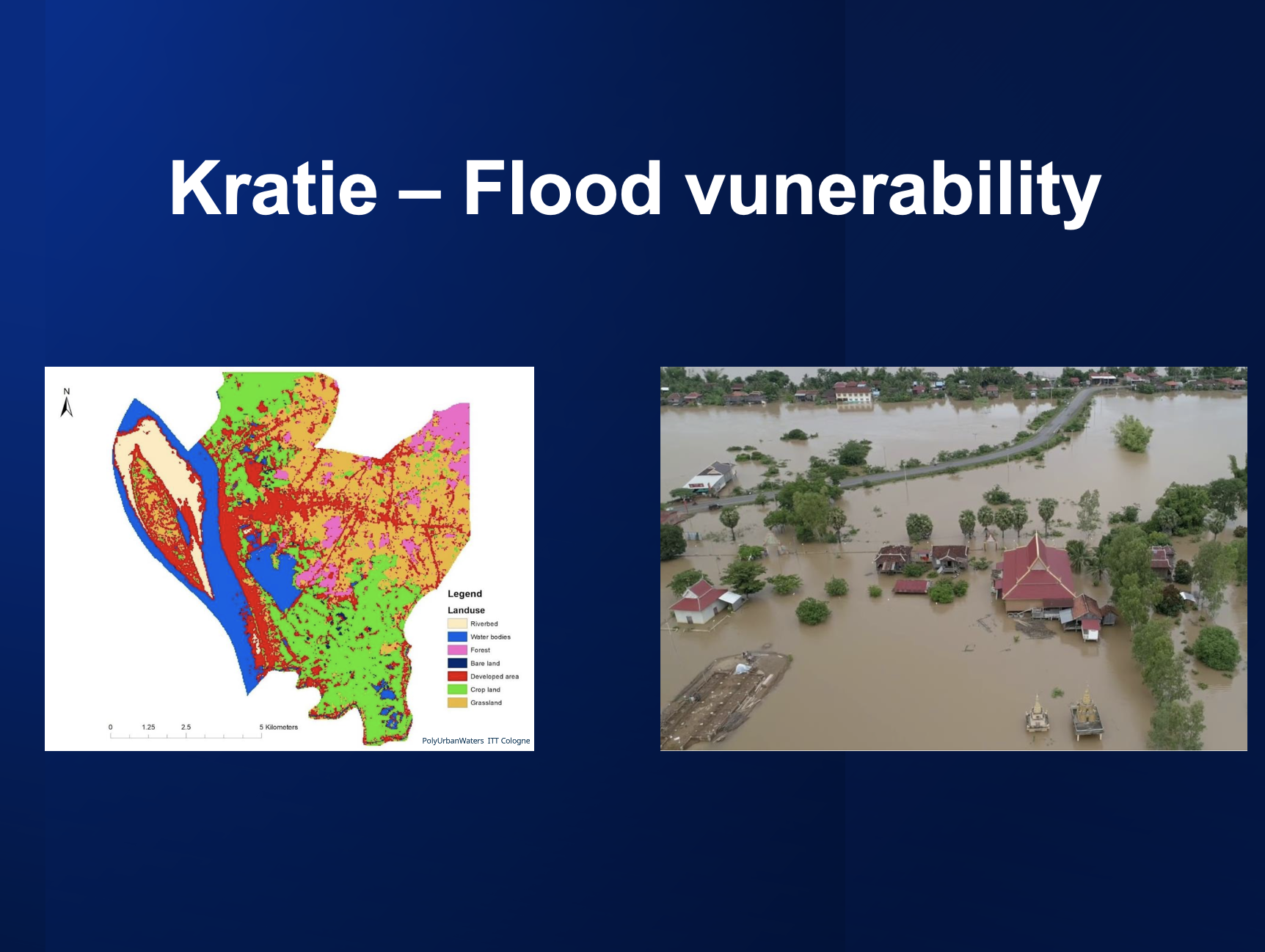
15 April 2022
Project Update 10 - Valorisation of peri-urban wetlands as strategic components of resilience to climate change
In March 2022, Polyurbanwaters’ international teams were able to conduct on-site analyses in Kratie/Cambodia again for the first time. Among other things, they examined the extent to which the city’s green infrastructure can be assessed in terms of its flood vulnerability and climate resilience. Situated on the Mekong River, an extensive wetland still extends at the back of the city today. This area has a significant influence on the water hydrology for the urban catchment area in general, is essential for the urban climate, holds a rich habitat and has an important function for agriculture and fishery, i.e. for the livelihoods of the communities. The wetland is coming under pressure, especially due to increasing construction activity, which will have significant implications for the economic, social and ecological development of the city and its urban catchment area. As the research of the PolyUrbanWaters team shows, the sustainable management of wetlands should be considered as a strategic element of urban development. A gradual disappearance of this area would not only mean a significant loss in terms of the tourism development envisaged by the city, but also a substantial loss of quality of life and livability. Warning examples can be observed on the drive from Phnom Penh to Kratie, where forestation has given way to dry savannah over the last forty years.
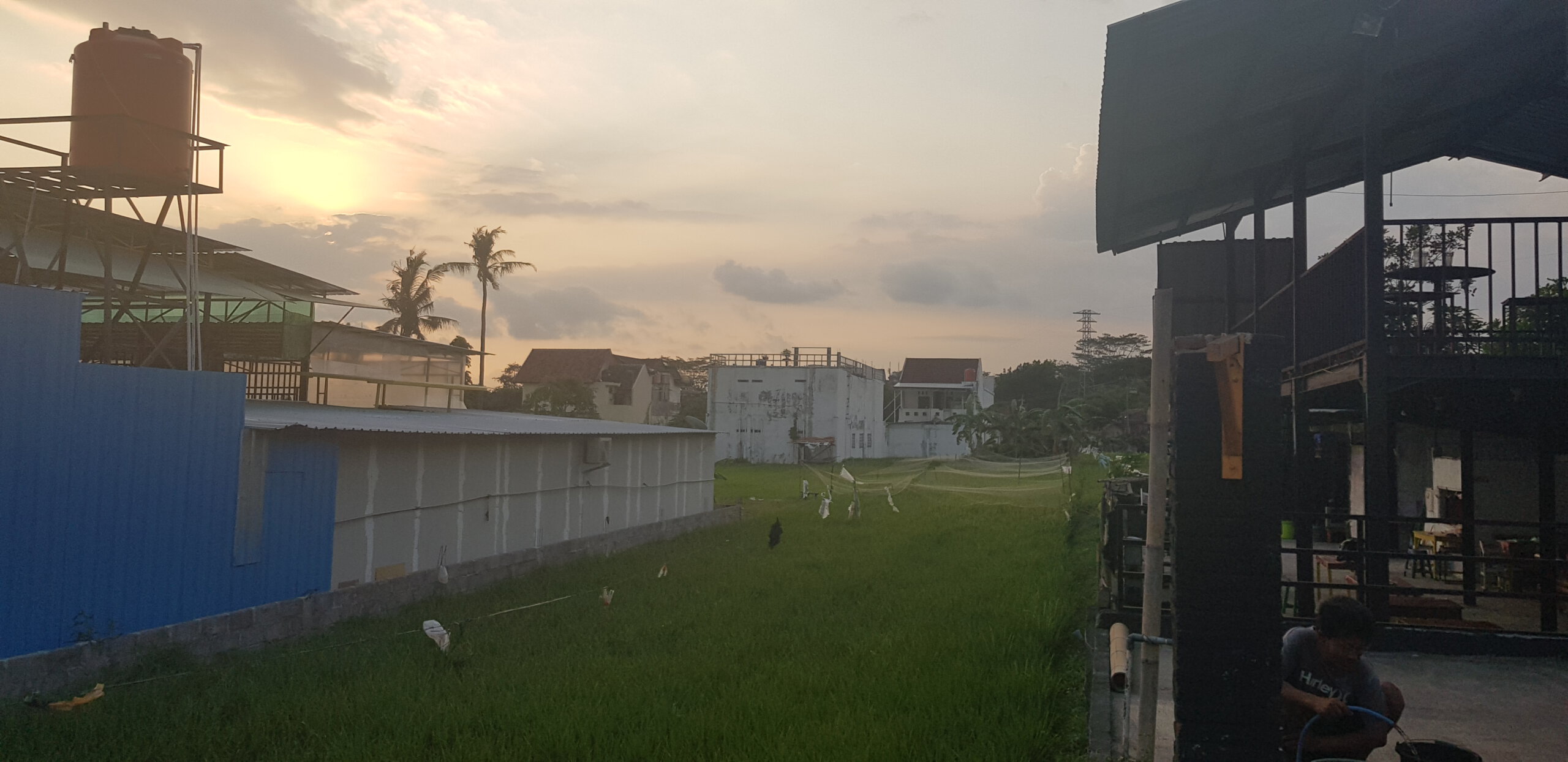
22 March 2022
Project update 9: Water governance and sustainable infrastructure development
Localising the SDGs through sustainable infrastructure development is a key focus of PolyUrbanWaters. Since 2020, PolyUrbanWaters has conducted detailed analyses of governance structures in Indonesia, Cambodia, Laos, Thailand and Vietnam that are essential for urban water management. Increasingly, it is common knowledge among decision-makers at the level of national and local governments and international development agencies that simply providing funding and implementing hardware is insufficient for the sustainable management of infrastructures and that building local capacity is essential for their sustainable management. In this context, public sector budgeting increasingly provides for the financing of so-called capacity development measures in addition to the financing of hardware (drainage systems, water treatment plants, etc.). However, PolyUrbanWaters’ research shows that capacity development alone (e.g. training of staff and local actors, technical equipment of local government) is only one essential element among others for sustainable infrastructure development. In this context, research by AIT in Thailand has shown that the high degree of fragmentation of responsibilities for urban water management at the national government level leads to the paralysis of decision-making processes down to the local level. Studies of the project in Cambodia have shown that investment decisions made at the national government level are only very partially aligned with the mandates of municipal governments and thus ultimately insufficiently integrated into local structures. Due to the unclear financing of the operation and maintenance of the infrastructure, its sustainable operation is questioned from the very beginning. In Indonesia, as part of its decentralisation policy, the national government is trying to strengthen public structures at the level of city districts and neighbourhoods, in addition to the cities themselves, in order to better promote infrastructure development from the respective local context. However, in practice, there is still a substantial need to clarify which mandates the respective governance structures have, how these are coordinated with each other at the different hierarchical levels and how capacities (e.g. urban planning, quarteries management, water management) can be developed to fulfil these tasks. In Laos, the regulatory status of the “city”, which has so far only been clarified to a limited extent, poses a major challenge for sustainable infrastructure development. The main decisions are made at national and provincial level. Especially in peri-urban zones, the responsibilities of local administrative units and provincial governments are not sufficiently coordinated, which makes effective water governance much more difficult. PolyUrbanWaters is in the process of analysing the interrelationships of polycentric approaches to water management (water supply, waste water management, storm water management, flood management, water safety zones, disaster management) in the context of the respective urban development dynamics and the given governance structures in the context of the current base-line studies in the partner cities of Kratie, Sam Neua and Sleman. A key objective is to support partner cities in identifying strategic projects that demonstrate effective and sustainable management of urban water resources. Here, not only the interrelationships between land use change (e.g. land sealing, loss of water buffers such as rice fields) and increased flood risk are shown. It also identifies possible solutions at the governance level to mitigate the unintended effects of urban development. This means that not only strategic options for the development or protection of green infrastructure, which are essential for urban flood management, are considered. It will also discuss with local stakeholder groups who is responsible for the sustainable management of these infrastructures (local government, communities, investors) and what the corresponding financing plans could look like.
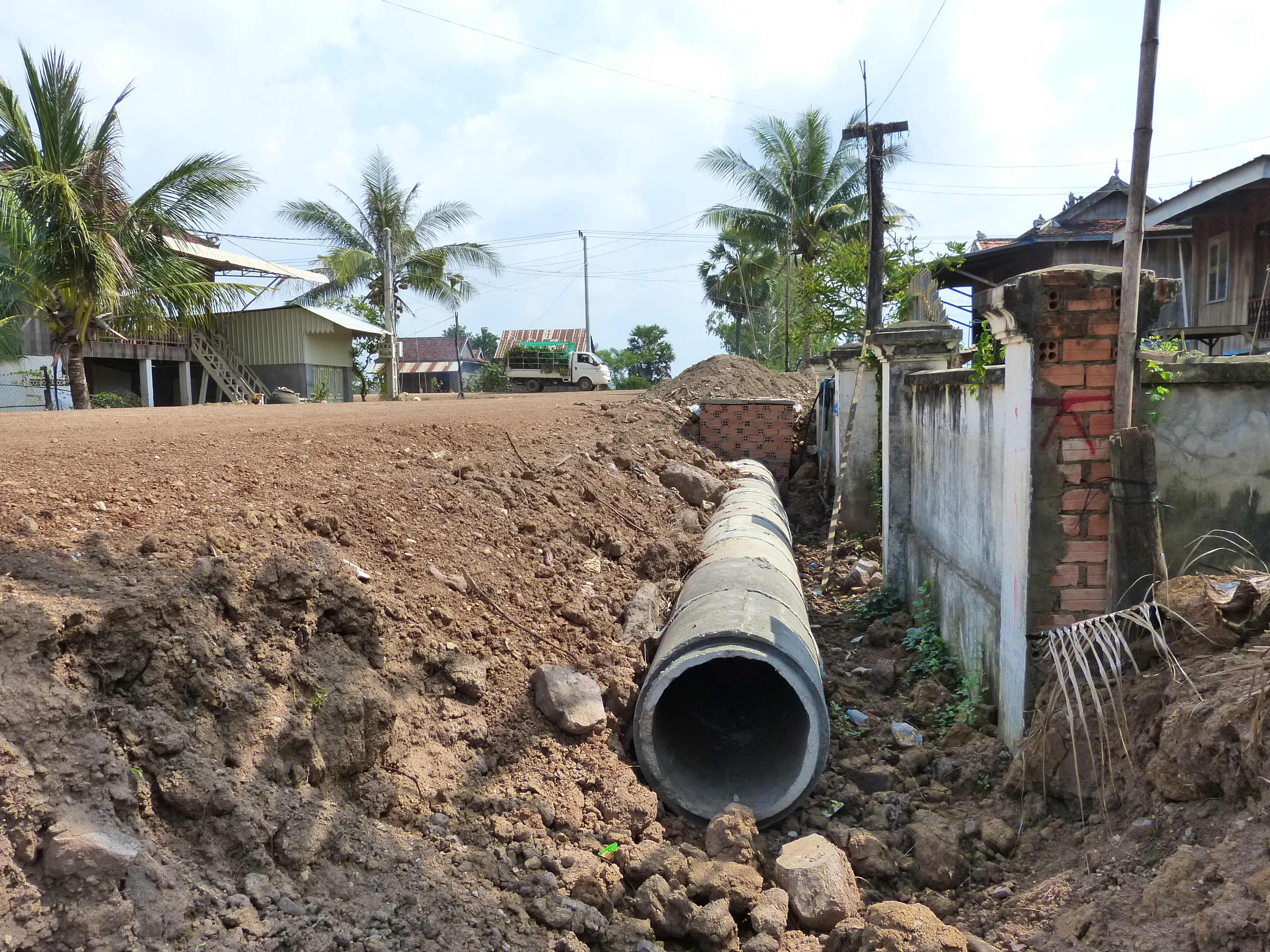
12 February 2022
Project update 8: Successful implementation of decentralisation policy as a prerequisite for successful localisation of the SDGs.
The analyses currently being carried out in PolyUrbanWaters’ partner cities show the efforts of national and city governments to build effective city administrations. It is increasingly recognised that the provision of public funding and the implementation of hardware alone are insufficient for a comprehensive and sustainable improvement of water security and the provision of water-related municipal services.Significant progress has been made in water supply and piped water provision in the last two decades. It is recognised by the relevant stakeholders in the partner cities that infrastructure development focused primarily on “output” (e.g. “x km of drainage system”, “x households provided with waste water treament infrstructure”, “x housholds provided with piped waters”) does not necessarily translate to the same extent into a qualitative improvement of municipal services.Inadequate planning and insufficient quality monitoring of the implemented hardware leads to a situation where quite a few funded systems are not operational from the beginning. The lack of embedding in local structures, unclear responsibilities for maintenance and operation and insufficient long-term funding are major challenges for sustainable use, even if the hardware is operational at handover.These challenges are now being recognised by national and local governments. Increasingly, public budgeting requires hardware development to go hand in hand with the establishment of effective local structures or effective municipal administrations as part of capacity building measures. This can be seen as an important step towards strengthening local structures at the local level - be it at the level of the city as a whole, the city districts or the neighbourhoods - for successful decentralisation policies.However, government structures still face considerable challenges in translating the goals and processual procedures defined in strategic documents such as papers on regional development plans, water policy, climate change adaptation policy into local governance practice. Effective municipal administrations require clear and transparent decision-making structures, essential decision-making competencies, sufficient funding and differentiated technical expertise at the planning, implementation and monitoring levels. This requires communication capacities that can ensure communication between the different institutions and hierarchical levels of urban administration as well as actors from the community level, civil society and the private sector.
PolyUrbanWatern’s research confirms, capacity development must go hand in hand with a practical clarification of the mandates of public institutions.
What is the effective and efficient division of responsibilities in urban planning and its implementation between national government, provincial government and municipal government? What are the mandates and responsibilities between governance structures between city government and citiy district government? What roles do governance structures at neighbourhood and community level have, or are they in practice clearly embedded in urban governance structures? When it comes to the realisation of integrated approaches, what is the division of tasks at the horizontal and vertical levels between the different municipal institutions?At first glance, these questions and tasks seem rather complex. However, they are ultimately indispensable for the municipalities of secondary and tertiary cities to be able to ensure their tasks with regard to water security and the provision of water-related urban services. An essential prerequisite for this transformation and capacity development process is qualifi
